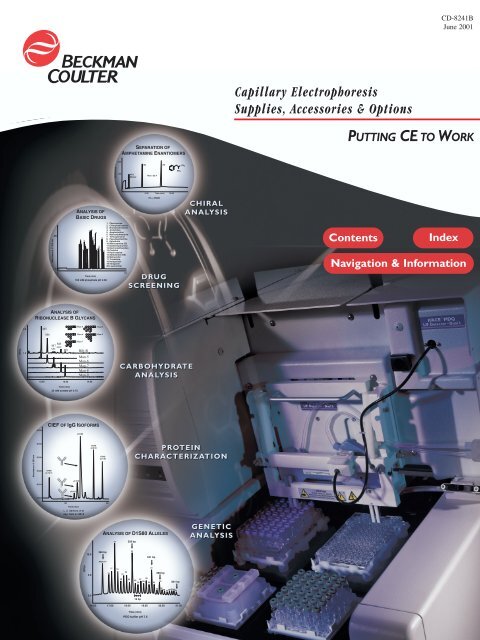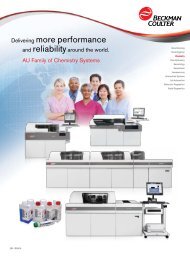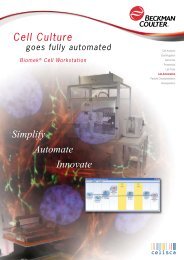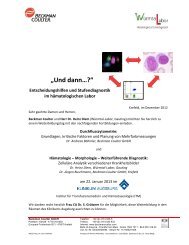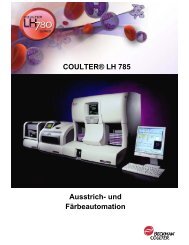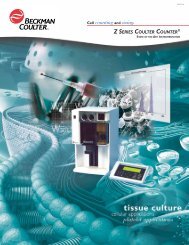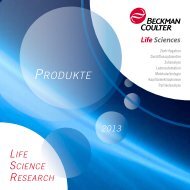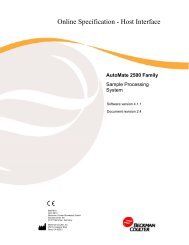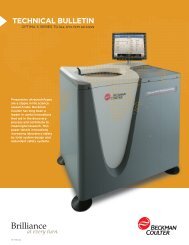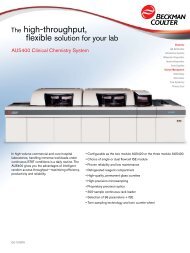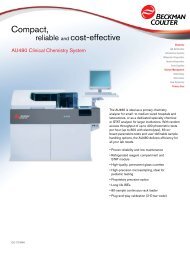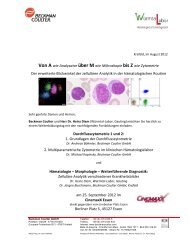p/ace™ mdq detectors - Beckman Coulter
p/ace™ mdq detectors - Beckman Coulter
p/ace™ mdq detectors - Beckman Coulter
- No tags were found...
Create successful ePaper yourself
Turn your PDF publications into a flip-book with our unique Google optimized e-Paper software.
CD-8241BJune 2001@<strong>Beckman</strong><strong>Coulter</strong>Capillary ElectrophoresisSupplies, Accessories & OptionsPUTTING CE TO WORKCHIRALANALYSISContentsIndexDRUGSCREENINGNavigation & InformationCARBOHYDRATEANALYSISPROTEINCHARACTERIZATIONGENETICANALYSIS
B ECKMAN C OULTERCapillary Electrophoresis<strong>Beckman</strong> Instruments, Inc., was founded by Dr. Arnold O. <strong>Beckman</strong> in 1935with the invention of the pH meter, a project initiated from a colleague’sneed to monitor the acidity of citrus juice. Since then, <strong>Beckman</strong> <strong>Coulter</strong>has grown into a 1.8 billion-dollar corporation with many scientific firsts to itscredit. Commercial electrophoresis systems were first introduced by <strong>Beckman</strong> in1953 with the development of the Model H, a Tiselius cell with Schlieren photographyand advanced optics. Since that time electrophoresis has played an important rolein <strong>Beckman</strong>’s bioresearch and clinical diagnostic developments.<strong>Beckman</strong>’s contributions to capillary electrophoresis (CE) began in 1989with the launch of the P/ACE 2000. This instrumentation boasted many CE firstsincluding a cartridge design with liquid thermostating of the capillary, micropreparativefraction collection and automated personal computer control. Sincethe introduction of the P/ACE, <strong>Beckman</strong> <strong>Coulter</strong> has been the acknowledged leaderin the development of CE technology with advancements in hardware, softwareand chemistry. These advancements included laser-inducedfluorescence, diode-array detection, independent sample and buffer temperaturecontrol, advanced CE data reduction and a myriad of CE chemistries.These advancements soon moved from generic CE to applied instrumentationfirst seen with the release of the Paragon ® CZE 2000, a multi-capillary system forautomated serum protein analysis in clinical diagnostics. This was soon followed bythe P/ACE MDQ, a rugged line of instrumentation for pharmaceutical/biotechnologymethods development and quality control. The CEQ 2000XL, a multi-capillary fullyautomated DNA Sequencing System, the dual-wavelength P/ACE MDQ LIF detectionsystem, and the P/ACE MDQ-LCQ CE-MS/MS system are the newest additions.<strong>Beckman</strong> <strong>Coulter</strong> continues to lead the field of capillary electrophoresis,strongly committed to further CE research and development. Our direction is guidedby you, to apply this core technology to systems providing key analytical solutions.<strong>Beckman</strong> <strong>Coulter</strong>ContentsIndex2
1989 1990 1991B ECKMANC OULTERP/ACE IntroductionImproved UVDetectionGold Softwarefor CEeCAP ssDNA100 KitI NNOVATIONSIN1992C APILLARYLaser-InducedFluorescenceDetectionMolecularWeight SoftwareCE-MS Adapter eCAP SDS 200Protein KitSample Cooling1993E LECTROPHORESISeCAP dsDNA1000 KitLIFluor dsDNA 1000 KitIsoelectricFocusingCapabilityEnhancedSensitivityCartridgeDiode ArrayDetectionP/ACE 5000eCAP SDS14-200Protein Kit19941995eCAP AmineCapillary MethodsDevelopment Kit–Small MoleculeseCAP AmineCapillary MethodsDevelopment Kit–ProteinseCAP NeutralCapillary MethodsDevelopmentKit/ProteinseCAP ChiralMethodsDevelopment KiteCAP dsDNA20,000 KiteCAP cIEF3-10 Kit635 LaserModuleThe ChiralSolutionParagon ® CZE2000 SerumProtein Analyzer19961997eCAP N-LinkedOligosaccharideProfiling KiteCAP ssDNA100-R KitTheCarbohydrateSolutionThe DNASolution1998P/ACE StationSoftwareP/ACEMDQP/ACE MDQQuality ControlSystem1999P/ACE MDQMethodsDevelopmentSystemP/ACE MDQChiral AnalysisSystemP/ACE 5000Series EducationSystemMDQ Kits- O3SNH2 -- O3S SO3 -APTSHighly SulfatedCyclodextrinsHS CDExternalDetector Adapter1.6 SoftwareEnhancementCEQ 2000DNA Sequencer2000APTSMonosaccharideGradeP/ACE MDQDual λ LIFP/ACE MDQGlycoproteinSystemP/ACE MDQCarbohydrateSystemP/ACE MDQDNA SystemP/ACEMDQ-LCQCE-MS/MSSystem32 Karat SoftwareVersion 4.0CEQ 2000XLLonger FasterReadsCEQ Chem KitDTCS – QuickStart ChemistriesCEQ 2000XLAutomatedHeterozygoteDetectioneCAPCarbohydrateLabeling Kit<strong>Beckman</strong> <strong>Coulter</strong>ContentsIndex3
CAPILLARY ELECTROPHORESISA SIMPLET ECHNIQUECapillary electrophoresis (CE) is a family of relatedseparation techniques that use narrow-bore fusedsilicacapillaries to separate a complex array oflarge and small molecules. High voltages are usedto separate molecules based on differences in charge,size and hydrophobicity. Injection into the capillary isaccomplished by immersing the end of the capillaryinto a sample vial and applying pressure, vacuumor voltage. Depending on the types of capillary andbuffers, CE can be segmented into several separationtechniques. Examples of these include:CAPILLARY ZONE ELECTROPHORESIS (CZE), also known asfree-solution CE (FSCE), is the simplest form of CE.The separation mechanism is based on differences inthe charge-to-mass ratio of the analytes. Fundamentalto CZE are homogeneity of the buffer solution andconstant field strength throughout the length of thecapillary. The separation relies principally on the pHcontrolleddissociation of acidic groups on the soluteor the protonation of basic functions on the solute.CAPILLARY GEL ELECTROPHORESIS (CGE) is the adaptationof traditional gel electrophoresis into the capillaryusing polymers in solution as a molecular sieve.This allows solutes having similar charge-to-massratios to be resolved by size.CAPILLARY ISOELECTRIC FOCUSING (CIEF) allows amphotericmolecules, such as proteins, to be separated byelectrophoresis in a pH gradient generated betweenthe cathode and anode. A solute will migrate to apoint where its net charge is zero. At this isoelectricpoint (the solute’s pI), migration stops and the sampleis focused into a tight zone. In cIEF, once a solutehas focused at its pI, the zone is mobilized past thedetector by either pressure or chemical means.Block diagramof basic CE system.The magnified view depictsthe capillary interior with moleculesof different size and charge separating. Asillustrated, in free-solution capillary electrophoresis, thepositive molecules migrate toward the negative electrodewhile the electroosmotic flow carries the neutral andnegatively charged molecules in the same direction.ISOTACHOPHORESIS (ITP) is a focusing technique based on the migrationof the sample components between leading and terminating electrolytes.Solutes having mobilities intermediate to those of the leadingand terminating electrolytes stack into sharp, focused zones.Although it is used as a mode of separation, transient ITP has beenused primarily as a concentration technique.ELECTROKINETIC CHROMATOGRAPHY (EKC) is a family of electrophoresistechniques named after electrokinetic phenomena, which includeelectroosmosis, electrophoresis and chromatography. A key exampleof this is seen with cyclodextrin-mediated EKC. Here the differentialinteraction of enantiomers with the cyclodextrins in combinationwith an electrophoretic field allows for the separation of chiralcompounds.MICELLAR ELECTROKINETIC CAPILLARY CHROMATOGRAPHY (MECC OR MEKC)is a mode of electrokinetic chromatography in which surfactants areadded to the buffer solution at concentrations which form micelles.The separation principle of MEKC is based on a differential partitionbetween the micelle and the solvent. This principle can be employedwith charged or neutral solutes and may involve stationary or mobilemicelles. MEKC has great utility in separating mixtures whichcontain both ionic and neutral solutes.CAPILLARY ELECTROCHROMATOGRAPHY (CEC) is a hybrid separationmethod that couples the high separation efficiency of CZE withHPLC, and uses an electric field rather than hydraulic pressure topropel the mobile phase through a packed bed. Since there is minimalbackpressure, it is possible to use small-diameter packings andachieve very high efficiencies.NON-AQUEOUS CAPILLARY ELECTROPHORESIS (NACE) involves the separationof analytes in a medium composed of organic solvents. Theviscosity and dielectric constants of organic solvents affect bothsample ion mobility and the level of electroosmotic flow. The useof non-aqueous medium allows additional selectivity options inmethods development and is also valuable for the separation of waterinsolublecompounds.`SummaryThe large selection of separation mechanisms combined with its“in solution” approach has allowed capillary electrophoresis toexcel where many analytical techniques have failed. CE has beensuccessful primarily with complex hydrophilic macromolecules andhighly charged solutes. These techniques have led to the rapidseparation and quantitation of:• Nucleic Acids• Proteins• Glycoproteins• Peptides• Carbohydrates• Basic Pharmaceuticals• Chiral Isomers• Inorganic and Organic Ions<strong>Beckman</strong> <strong>Coulter</strong>ContentsIndex4
THE BECKMAN COULTER FAMILY OF CE SYSTEMS<strong>Beckman</strong> <strong>Coulter</strong>’s history, knowledge and leadershipin Capillary Electrophoresis has lead to the creationof the P/ACE and CEQ product lines. From its firstcommercial instrument shipment in 1989, <strong>Beckman</strong><strong>Coulter</strong>’s leadership has established the largestproductive base of CE instruments and users in theworld. CE product development has been guided bysuggestions from this large customer base as well ascollaborative work with experts in the field. Thepresent CE family is the result of these efforts.S UMMARYThe P/ACE Series are automated, programmablecapillary electrophoresis systems designed to performfast separations from complex samples. Separationsoccur in a capillary which is housed in an interchangeable cartridgewith circulating liquid coolant for efficient temperature control.This finely regulated temperature control allows the use of highionic-strengthbuffers and large-bore capillaries necessary foranalyzing difficult samples. With CE, methods are fast to develop,easy to validate, and cost effective to run. However, specializedsystem designs are required to optimize performance for differentapplications. To address these needs, <strong>Beckman</strong> offers a family ofCE instruments developed to apply CE technology to a variety ofchallenging applications.Each system includes components necessary to beginimmediate operation, such as vials, capillaries, and test mix.All systems include installation and basic training by qualifiedField Service Engineers.B ECKMAN C OULTER CE SY STEMSP/ACE MDQQ U ALITYC ONTROLS Y STEMP/ACE MDQM ETHODSD EVELOPMENTS Y STEMP/ACE MDQC HIRALA NALYSISS Y STEMP/ACE MDQG LYCOP ROTEINA NALYSISS Y STEMP/ACEMDQ DNAS Y STEMCEQ2000XLDNAS EQUENCERP/ACEMDQ-LCQCE- MS/MSP ARAGON ®CZE 2000SERUM PROTEINTEINANALYZERP/ACE MDQ SYSTEMS........................................6P/ACE MDQ AND CEQ SYSTEMS ...........................9P/ACE MDQ MODULES .....................................10D ETECTORO PTIONS.........................................11P/ACE MDQ/5000 SERIES D ETECTOR A CCESSORIES ...12CE SYSTEM S OFTWARE .....................................14CE SUPPLIES ................................................15CE APPLICATIONCE CHEMISTRYT ABLE OF C ONTENTSK ITS......................................22K ITS........................................35L ABWARE ....................................................38CE SUPPLIES AND L ABWARE ...............................40C USTOMER S UPPORT ........................................42C APILLARY E LECTROPHORESIS E DUCATIONAL A IDS .......44T ECHNICAL & APPLICATION I NFORMATION ................46I NDEX ........................................................50<strong>Beckman</strong> <strong>Coulter</strong>Index5
P/ACE MDQThe P/ACE MDQ is an advanced CE system designed, in terms of flexibility and capacity, to meet the different requirements of research,methods development and quality control laboratories. Each configuration is available with a series of options to customize to meet end-userrequirements.All P/ACE MDQ configurations combine hardware, software and chemistry with worldwide technical support. A choice of interchangeable<strong>detectors</strong> meets the needs of a wide range of applications. The software automates all operations, from direct instrument control to data acquisition,analysis and reporting. At the heart of the MDQ is the system’s flexibility in programming and capacity. In methods development, samples can beautomatically run against an array of up to 36 different pairs of buffers, while in quality control the buffer array can be switched for buffer capacity(large volume reservoir) enabling routine analysis of up to 96 samples. The P/ACE MDQ works with a range of sample vessels accommodating96-well plates or a 48-position tray that holds 2 mL vials, 0.5 mL tubes and PCR* reaction vials. The system’s built in software features assistin meeting GLP and CGMP compliance requirements. P/ACE MDQ is specially designed to meet industry’s demands for ruggedness and safety.<strong>Beckman</strong> <strong>Coulter</strong> validates system performance upon installation and provides a comprehensive compliance protocol.* PCR is covered by U.S. patents owned by Hoffmann-La Roche Inc.P/ACE MDQ Methods Development SystemPART NUMBERPART NUMBER149817 North America International 285400A CE-based analytical system configured optimally for the methodsdevelopment process, where a focus is placed on spectral analysis and theautomation of separation strategies. The system includes a P/ACE MDQconfigured with both a photo diode array and selectable-wavelength UV/Vis(200, 214, 254 and 280 nm filters included) detector, UV source optics,temperature-controlled sample storage module and 32 Karat Softwareconfigured on an IBM personal computer. Installation Qualification,Operation Qualification 1 (OQ1) and documentation to aid in softwarevalidation is also included.Starter chemistries: P/ACE MDQ Methods Development Kit, AmineCapillary Validation Pack and the Neutral Capillary Validation Pack.P/ACE MDQ Chiral SystemPART NUMBERPART NUMBER149833 North America International 285402A CE-based analytical system configured optimally for developing methodsfor the separation of enantiomers. The system includes a P/ACE MDQconfigured with a photo diode array detector, UV source optics, ambientsample storage module and 32 Karat software configured on an IBMpersonal computer. Installation Qualification, Operation Qualification 1(OQ1) and documentation to aid in software validation is also included.Starter chemistries: The Highly Sulfated Cyclodextrins chiral methodsdevelopment pack (strategy # 1), Neutral CD Chiral Methods DevelopmentKit (strategy #2), and Chiral Methods Development Guide.P/ACE MDQ Quality Control SystemPART NUMBERPART NUMBER149815 North America International 285401<strong>Beckman</strong> <strong>Coulter</strong>ContentsA CE-based analytical system configured optimally for the qualityassurance laboratory. With a focus on repetitive robust analyses, thesystem includes a P/ACE MDQ configured with a filter-based selectablewavelengthUV/Vis (200, 214, 254 and 280 nm included) detector,UV source optics, ambient sample storage module, and 32 Karat Softwareconfigured on an IBM personal computer. Installation Qualification,Operation Qualification 1 (OQ1), and documentation to aid in softwarevalidation are also included.Index6
P/ACE MDQP/ACE MDQ-LCQ CE-MS/MS SystemsPART NUMBERPART NUMBER149016These systems feature single-point control of both the ThermoFinniganLCQ and the <strong>Beckman</strong> <strong>Coulter</strong> P/ACE MDQ using the Xcalibur workstation. The P/ACE MDQ is configured with diode array detection,sample tray temperature control, and capillary temperature controlextended to an electrospray interface. The unique system interfaceemploys a liquid sheath make-up flow to sweep the analytes off thecapillary and into the mass spectrometer. The LCQ utilizes ion traptechnology to resolve the molecular ions and is capable of MS/MS—allowing these ions to be isolated and further fragmented to gainstructural information and higher confidence confirmation. Thesesystems have been optimized for capillary lengths and instrumentlevels—and configured for the following three applications (pleasecontact your local <strong>Beckman</strong> <strong>Coulter</strong> representative for a quotation onthe following systems):1) CE-MS/MS Protein Characterization System2) CE-MS/MS Pharmaceutical Analysis System3) CE-MS/MS Research SystemP/ACE MDQ Glycoprotein SystemPART NUMBERPART NUMBER149893 North America International 149872CE-based system for the separation and characterization of proteinsand associated carbohydrates. The system is ideal for peptide mapping,separation of proteins by molecular weight, accurate isoelectric point(pI) determination, oligosaccharide profiling and monosaccharideanalysis. System includes a P/ACE MDQ configured with a selectablewavelength UV/Vis (200, 214, 254 and 280 nm included) detector,UV source optics, laser-induced fluorescence detector, 488 nm argonion laser module, a temperature-controlled sample storage module,and 32 Karat Software configured on an IBM personal computer.Installation Qualification, Operation Qualification 1 (OQ1) anddocumentation to aid in software validation is also included.Starter chemistries: eCAP Carbohydrate Labeling and Analysis Kit,eCAP SDS 14-200 Kit, MDQ Methods Development kit, LIF and UVdetector test mix, and Glycoprotein Methods Development Guide.<strong>Beckman</strong> <strong>Coulter</strong>ContentsIndex7
P/ACE MDQP/ACE MDQ Molecular Characterization SystemPART NUMBERPART NUMBER149891 North America International 149863A CE-based system for the analysis of nucleic acids and their subsequentinteractions with proteins. The system provides clear advantagesover traditional electrophoresis for DNA quantitation (viral load, geneexpression), synthetic oligonucleotide purity analysis, mutation analysis,size polymorphisms analysis (VNTR, STR, microsatellites, RFLP,RAPD) and the study of DNA/protein interactions. System includesa P/ACE MDQ configured with a selectable-wavelength UV/Vis(200, 214, 254 and 280 nm included) detector, UV source optics, dualwavelengthlaser-induced fluorescence detector, 488 nm argon ion lasermodule, a temperature-controlled sample storage module, and 32 Karat Software configured on an IBM personal computer. InstallationQualification, Operation Qualification 1 (OQ1) and documentationto aid in software validation is also included.Starter chemistries: P/ACE MDQ Methods Development Kit, eCAP ssDNA 100 kit, eCAP dsDNA 1000 kit, eCAP dsDNA 20,000 kit,EnhanCE DNA intercalator, LIF and UV detector test mix, andMolecular Characterization Applications Guide.P/ACE MDQ Carbohydrate SystemPART NUMBERPART NUMBER2.01.0A0.1 N TFA hydrolyzedAldolase treatedB2.0 N TFA hydrolyzedReacetylatedRSix monosaccharidesGalNAcGlcNAcManGalNAc GlcNAcMan Nac from Neu5AcManGlc Fuc GalGalStandard2.00 4.00 6.00 8.00 10.00149890 North America International 149896A CE-based system for the separation and analysis of carbohydrates. Thesystem is ideal for both oligosaccharide profiling and monosaccharideanalysis. System includes a P/ACE MDQ configured with a laser-inducedfluorescence detector, 488 nm argon ion laser module, an ambient samplestorage module, and 32 Karat Software configured on an IBM personalcomputer. Installation Qualification, Operation Qualification 1 (OQ1)and documentation to aid in software validation is also included.Starter chemistries: eCAP Carbohydrate Labeling and Analysis Kit andCarbohydrate Methods Development Guide.<strong>Beckman</strong> <strong>Coulter</strong>ContentsIndex8
P/ACE MDQ AND CEQ SYSTEMSP/ACE MDQ DNA SystemPART NUMBERPART NUMBER149892 North America International 149874A CE-based system for the analysis of nucleic acids. The system providesclear advantages over traditional electrophoresis for DNA quantitation(viral load, gene expression), mutation analysis, and size polymorphismsanalysis (VNTR, STR, microsatellites, RFLP, RAPD). System includesa P/ACE MDQ configured with a laser-induced fluorescence detector,488 nm argon ion laser module, an ambient sample storage module, and32 Karat Software configured on an IBM personal computer. InstallationQualification, Operation Qualification 1 (OQ1) and documentation to aidin software validation is also included.Starter chemistries: eCAP dsDNA 1000 kit, eCAP dsDNA 20,000 kit,EnhanCE DNA intercalator, LIF detector test mix, and Nucleic AcidsMethods Development Guide.CEQ 2000XL DNA ANALYSIS S Y STEMThe CEQ 2000XL DNA Analysis System is a fully automated, high-throughput sequencing and fragment analysis system. Capillaryelectrophoresis technology and laser-induced fluorescence detection have been combined to provide a very easy to use microplatebasedsystem. The CEQ is designed to handle all aspects of the DNA analysis process from sample denaturation through automaticbase or allele calling, with no user intervention, following an easy ten minute setup.KEY FEATURES OF THE CEQ 2000XL• Linear Polyacrylamide Gel matrix inside a coated capillary array provides the best read length/cycle time and the highest accuracyof any CE-based sequencer.• Eight capillary array to eliminate plate cleaning, gel casting, and tedious DNA sample loading.• 96-well microplate format.• Automated: loading of separation gel, sample denaturation, and sample loading.• Automatically switches between sequencing applications and fragment analysis on the same plate.For Sequencing:• Longer reads and faster cycle times (>700 bases in less than 100 minutes at better than 98% accuracy).• Short reads and faster cycle times (>500 bases in less than 45 minutes at better than 98% accuracy).• Dideoxy-terminator cycle sequencing kits with four “WellRED” fluorescence dyes (one-tube chemistry).• Raw data and analyzed data available in most popular formats.• Confidence values and call scores provided with each base determined.For Fragment Analysis:• Automated allele determination.• Precisely sized microsatellite amplification products to a S.D. of ≤0.27 bases.PART NUMBER285501 WorldwideThe CEQ 2000XL DNA analysis system is a fully automated, highperformancesequencing and fragment analysis system, employing aneight-capillary array to increase sample throughput, and specializedlaser-induced fluorescence detection optics with WellRED dyes(infrared emission) for unsurpassed performance in dideoxy terminatorcycle sequencing. Sample introduction is done directly from a 96-wellmicroplate, compatible with most forms of sample prep automation.The CEQ 2000XL handles all aspects of the DNA analysis process,from sample denaturation through automatic base or allele calling withno user intervention. This system includes the CEQ 2000XL instrument,software for both sequencing and fragment analysis, an IBMworkstation, installation and basic training.<strong>Beckman</strong> <strong>Coulter</strong>ContentsIndex9
P/ACE MDQ MODULESThe following instruments are packaged with appropriate shipping kits to ensure rapid installation, but they do not includecomputer workstations, software or accessories. See previous section for complete packages. The purpose of these systemsis to allow you to purchase basic modules to add on to existing systems.PART NUMBERDESCRIPTION144000 P/ACE MDQ – PDAIncludes P/ACE MDQ with photodiode array detector and ambientsample storage module.144001 P/ACE MDQ – UV AmbientIncludes P/ACE MDQ with UV/Vis detector and ambient samplestorage module.144002 P/ACE MDQ – PDA – Sample Temp. ControlIncludes P/ACE MDQ with Diode Array Detector and temperaturecontrolledsample storage module.144003 P/ACE MDQ – UV – Sample Temp. ControlIncludes P/ACE MDQ with UV/Vis detector and temperature-controlledsample storage module.<strong>Beckman</strong> <strong>Coulter</strong>ContentsIndex10
DETECTOR OPTIONSP/A C E MDQ DETECTORS<strong>Beckman</strong> <strong>Coulter</strong> believes that an analytical instrument should be able to evolve to meet changing requirements.The following detector modules are plug-in units that are easy to switch once they are installed.PART NUMBERDESCRIPTION144733 P/ACE MDQ UV/Vis Detector ModuleConsists of UV/Vis detector, UV optics cable, 200 nm, 214 nm, 254 nm,and 280 nm filters.149819 P/ACE MDQ Diode Array Detector Upgrade KitConsists of DAD detector, DAD optics cable, and DAD board.149852 P/ACE MDQ External Detector Adapter (EDA)Accessory KitComplete kit for the addition of EDA to MDQs shipped withversion 1.5 software and higher. These MDQs will already haveEDA-compatible hardware and firmware. Kit also includes a hydraulicleveling table. Service installation included.144954 P/ACE MDQ Dual λ LIF DetectorIncludes LIF Dual Detector Module, Interconnect Module, LIFCartridge Plug and Stabilizer. Allows two emission wavelengths to bedetected simultaneously. For further information, see DS-8284A.144901 P/ACE MDQ Single λ LIF DetectorIncludes LIF Detector Module, Interconnect Module, LIF CartridgePlug and Stabilizer.Laser Modules727620 Argon Ion – 488 nm (120 V)727621 Argon Ion – 488 nm (220 V)727622 Argon Ion – 488 nm (240 V)727619 Argon Ion – 488 nm (100 V)267839 635 nm Diode Laser<strong>Beckman</strong> <strong>Coulter</strong>ContentsIndex11
P/ACE MDQ/5000 SERIES DETECTOR ACCESSORIESPART NUMBERDESCRIPTIONLIF Detector Filters for P/ACE 5000 Series360672 LIF Detector Filter Holder961640 LIF 488 nm Notch Filter960323 LIF 520 nm Emission Bandpass Filter890880 LIF 530 nm Emission Bandpass Filter890879 LIF 560 nm Emission Bandpass Filter725412 LIF 675 nm Emission Bandpass FilterUV FiltersFilters can be purchased for replacement or custom applications andare customer installed. These filters are compatible with both theP/ACE 5000 and the P/ACE MDQ instruments.144430 Filter, 200 nm144431 Filter, 210 nm144437 Filter, 214 nm144432 Filter, 220 nm144433 Filter, 230 nm144438 Filter, 254 nm144434 Filter, 260 nm144439 Filter, 280 nm144435 Filter, 300 nm144436 Filter, 340 nmLIF Detector Filters for P/ACE MDQ Series144941 488 nm Notch Filter144940 520 nm Bandpass Filter144942 663 nm Longpass Filter<strong>Beckman</strong> <strong>Coulter</strong>ContentsIndex12
P/ACE MDQ/5000 SERIES DETECTOR ACCESSORIESMiscellaneous SuppliesPART NUMBERDESCRIPTION360671 LIF Fiber-Optic Cable for Laser withSMA905 Connector (quantity 1)726022 LIF Test Mix, Sodium Fluorescein (20 mL)477615 635 LIF Calibration/Test Standard144667 Deuterium Lamp Assembly, P/ACE MDQReplacement part (quantity 1).142205 Deuterium Lamp Assembly, P/ACE 5000 SeriesReplacement part (quantity 1).359058 Deuterium Lamp Assembly, P/ACE 2000 SeriesReplacement part (quantity 1).144093 Replacement UV/Vis Fiber Optic Cable for theP/ACE MDQ144094 Replacement DAD Fiber Optic Cable for theP/ACE MDQ<strong>Beckman</strong> <strong>Coulter</strong>ContentsIndex13
CE SYSTEM SOFTWARE32 KARAT S OFTWARE AND W ORKSTATIONS32 Karat software is a new platform for P/ACE MDQ system control, data collection, and analysis. This new platform wasdeveloped entirely in 32-bit code to fully utilize the functionality of the Windows * NT and Windows 2000 operating systems.32 Karat software preserves data integrity with features such as user-specific log-in, independent audit trails, and results sign-off—ideal for research, biotechnology, or pharmaceutical laboratories. 32 Karat software adds analysis dimensions that significantlyincrease the accuracy of compound identification. New Peak identification algorithms allow the P/ACE MDQ to combine ananalyte’s mobility with spectral information for accurate identification against a large database of compounds. Data may also beplotted as a function of either migration time or mobility.Each 32 Karat workstation is capable of running up to four P/ACE MDQ systems with multiple channels. 32 Karat softwarehas been developed using documented processes and is fully validated at <strong>Beckman</strong> <strong>Coulter</strong>. The 32 Karat Workstation includes acomputer platform that has been validated by <strong>Beckman</strong> <strong>Coulter</strong> for the operation of 32 Karat software.PART NUMBERDESCRIPTION285510 32 Karat Workstation for P/ACE MDQIncludes 32 Karat software installed on an IBM computer with Windows NTsoftware. Six hours of user training are also included. Contact <strong>Beckman</strong><strong>Coulter</strong> sales for the current computer configuration.285512 32 Karat Software (User Installed)Includes 32 Karat software and six hours of user training. Requires acompatible computer platform (please contact your local <strong>Beckman</strong> <strong>Coulter</strong>representative).285511 32 Karat Workstation – Migration UpgradeIncludes 32 Karat software installed on an IBM computer with Windows NTsoftware. A migration guide to assist you in moving your data and methodsfrom the P/ACE MDQ software to 32 Karat software and 6 hours of usertraining are included. This migration offer requires you to return your existingP/ACE MDQ software key to <strong>Beckman</strong> <strong>Coulter</strong> (please contact yourlocal <strong>Beckman</strong> <strong>Coulter</strong> representative).285514 32 Karat Software – Migration Upgrade(User Installed)Includes 32 Karat software and six hours of user training. Requires acompatible computer platform (please contact your local <strong>Beckman</strong><strong>Coulter</strong> representative). A migration guide to assist you in moving yourdata and methods from the P/ACE MDQ software to 32 Karat softwareand 6 hours of user training are included. This migration offer requires youto return your existing P/ACE MDQ software key to <strong>Beckman</strong> <strong>Coulter</strong>.149948 32 Karat Software Reprocessing KeyAllows reprocessing of data collected on 32 Karat software at aremote or network location (does not provide instrument control).149989 32 Karat Software Validation PackSystem requirements, specifications, intended use, development lifecycle quality programs, and validation process are documented, allowingthis information to be used as a “remote audit” to support the validationof <strong>Beckman</strong> <strong>Coulter</strong> COTS (Commercial Off-The-Shelf) analyticalsoftware. Site audits at <strong>Beckman</strong> <strong>Coulter</strong> in Fullerton are also available.PC Accessory PakIncludes keyboard (local language version), monitor and PC power cords.144930 French Version144931 German Version144932 Italian Version144933 Spanish Version144934 U.K. Version<strong>Beckman</strong> <strong>Coulter</strong>ContentsIndex14
CE SUPPLIESC APILLARIESAll methods development in CE begins with the choice of the correctcapillary surface. The goal is to choose a surface which will not interactwith the sample and, depending upon the application, one which willeither reduce or induce electroosmotic flow. <strong>Beckman</strong> <strong>Coulter</strong> offers achoice of several types of capillaries, which range in surface chemistryallowing a variety of samples to be analyzed including pharmaceuticals,industrial chemicals, chiral drugs, nucleic acids, amino acids, proteinsand peptides. These capillaries are available in defined lengths, whichmay be trimmed to optimize instrument type, speed and resolution.N EUTRALS URFACESNeutral surfaces are designed to coat the exposed silanol groups on the fused silica and serve two major functions: 1) to reduceelectroosmotic flow, and 2) to prevent wall interaction with the sample. However, not all neutral surfaces are the same and it isimportant to understand what the surface is composed of to ensure that other interactions (i.e., hydrophobic) do not replace theionic interactions you are trying to reduce. For example, when using a neutral capillary with a surface consisting of a hydrophobicbonded phase, it is essential to include hydrophilic polymers in the buffer to prevent hydrophobic interactions. The following isa list of neutral surfaces that are available from <strong>Beckman</strong> <strong>Coulter</strong>. All of these surfaces are bi-layers, consisting first of a bondedphase to shield the silanol groups followed by a hydrophilic polymer to prevent hydrophobic interaction.PART NUMBERDESCRIPTION477441 eCAP Neutral Capillary, 50 µm I.D.,45 cm total length, 12 cm from window to outlet(quantity 1)The neutral capillary utilizes a secondary layer of polyacrylamideto generate a hydrophilic surface. This is a general purpose capillary,which <strong>Beckman</strong> <strong>Coulter</strong> recommends as a starting point for handlingcomplex samples like proteins or basic molecules. Polyacrylamidesurfaces are recommended for use with both UV and LIF detectionsystems but may show some reduction in capillary life with diodearraydetection systems.477601 eCAP N-CHO Capillary, 50 µm I.D.,65 cm total length, 12 cm from window to outlet(quantity 1)The N-CHO capillary utilizes a secondary layer composed of polyvinylalcohol (PVA). This surface is ideal for the separation of complex sampleslike proteins or basic pharmaceuticals in cases where minimal EOFis desired. PVA is a very rugged surface, which is stable with UV, LIFand diode array detection systems. However, due to the chemical natureof PVA, it is not recommended for use with borate buffer systems, asthe borate ion will complex with the surface. This capillary has beenfeatured in the Carbohydrate Labeling and Analysis Kit (P/N 477600).<strong>Beckman</strong> <strong>Coulter</strong>ContentsIndex15
CE SUPPLIESN EUTRAL S URFACES ( CONTINUED)PART NUMBERDESCRIPTION241521 eCAP Neutral Capillary (SDS-MW),100 µm I.D., 65 cm total length,12 cm from window to outlet (quantity 1)This capillary has been optimized for use with the eCAP SDS 14-200kit (separation of proteins by molecular weight). The capillary utilizesa 100 µm I.D. which allows increased sample loads, ideal for isolationof an analyte by fraction collection.477477 eCAP Neutral Capillary (DNA), 100 µm I.D.,65 cm total length, 12 cm from window to outlet(quantity 1)This capillary has been optimized for use with <strong>Beckman</strong> <strong>Coulter</strong>DNA chemistries. The capillary utilizes a 100 µm I.D. which allowsincreased sample loads, ideal for isolation of an analyte by fractioncollection.1st and 240th runs of basic proteins on a neutralcapillary. %RSD for migration time: Lysozyme—0.47%,Cytochrome C—0.51%, and Ribonuclease A—0.96%.<strong>Beckman</strong> <strong>Coulter</strong>ContentsIndex16
CE SUPPLIESA MINES URFACESAlthough basic compounds can be analyzed effectively at low pH, there are circumstances where one may wish to operate at ahigher pH to better differentiate sample mobility, effect solubility or induce electroosmotic flow. The amine capillary was generatedfor this purpose. The <strong>Beckman</strong> <strong>Coulter</strong> amine capillary utilizes a dynamic coating that, by washing with the amine regeneratorbetween runs, assures a uniform capillary coating from run to run. This capillary has been used effectively for basic proteins, basicdrugs and even for the separation of glycoforms. The surface is a cross-linked polymer with a quaternary ammonium ion providinga uniform positively charged surface and a consistent electroosmotic flow.PART NUMBERDESCRIPTION123 4 567834 5 72 86477431 eCAP Amine Capillary, 50 µm I.D.,65 cm total length, 12 cm from window to outlet(quantity 1)This capillary has been coated with the amine polymer and must beused in combination with the amine regenerator solution P/N 477433.477433 eCAP Amine Capillary, 75 µm I.D.,65 cm total length, 12 cm from window to outlet(quantity 1)This capillary has been coated with the amine polymer and must beused in combination with the amine regenerator solution P/N 477433.1The eCAP Amine capillary improves resolution of basicdrugs. (1)-Impurity, (2)-Doxepin, (3)-Nordoxepin,(4)-Imipramine, (5)-Desipramine, (6)-Amitriptyline,(7)-Nortriptyline, (8)-Protriptyline.<strong>Beckman</strong> <strong>Coulter</strong>ContentsIndex17
CE SUPPLIESU NTREATED F USED-SILICA C APILLARIES<strong>Beckman</strong> <strong>Coulter</strong> bare fused-silica capillaries are routinely used for a variety of CE separations. The pKa of fused silica isabout 1.5. The degree of ionization of the walls of these capillaries is controlled by the pH of the buffers used for separation.F USED-SILICAC APILLARIESPre-Burned Windows20 µm I.D. × 50 µm I.D. × 75 µm I.D. × 100 µm I.D. ×375 µm O.D. 375 µm O.D. 375 µm O.D. 375 µm O.D.33847520 cm effective lengthquantity 333845150 cm effective lengthquantity 333845450 cm effective lengthquantity 3360801111 cm total length tointerface to EDA20 cm to windowquantity 3360800111 cm total length tointerface to EDA20 cm to windowquantity 3149053115 cm total length; 100 cmto window. Methods developmentcapillary for CE-MS/MS system.Without Pre-Burned Windows3608045 meters total length3384725 meters total length3384735 meters total length3384745 meters total lengthCEQ 2000XL CAPILLARY A RRAYSEach array has eight coated capillaries, complete with inlet electrode cannula and detector array fitting. Ready for easy installationinto the CEQ 2000XL. Each capillary will last at least 100 runs depending on method used, enabling at least 800 separations to beperformed before replacement. Storage temperature: 6°C.PART NUMBERDESCRIPTION608015 CEQ DNA Separation Array, 50–100 µm50 cm in length, 100 µm I.D., 200 µm O.D.608087 CEQ DNA Separation Array, 33–75 µm33 cm in length, 75 µm I.D., 200 µm O.D.<strong>Beckman</strong> <strong>Coulter</strong>ContentsIndex18
CE SUPPLIESP/ACE MDQ CARTRIDGES AND A CCESSORIESPART NUMBERDESCRIPTION144738 Blank Cartridge Assembly KitContains cartridge body, 100 × 800 µm aperture, tubing kit, nuts,ferrules, and O-rings. Compatible with aqueous buffer systems.149044 Blank Cartridge – CE-MS/CEC KitFor use with CE-MS/MS or CEC applications where organic solventsare primarily used. Kit contains cartridge body, 100 × 800 µm aperture,tubing kit, nuts, ferrules, and O-rings.144645 Cartridge Rebuilding KitContains capillary length template, cleaving stone, rebuild instructions,dual seals, single seals, clips, O-rings, installation tool, and tweezers.970297 Cartridge Aperture O-Rings (quantity 2)144689 Cartridge Tubing KitConsists of 20-, 30-, 40-, and 50-cm lengths of heat-formed tubingand all connectors.144717 Cartridge Tube Kit 100Cartridge coolant tubing (100 cm total length).144866 Cartridge Clip with Dual Seal(quantity 4 red seals)Capillary cartridge clip and dual seal is designed to seal the capillaryjunction between the bottom of the P/ACE MDQ cartridge and theinterface block. Seal can be used for capillaries with outside diametersas small as 150 µm.144873 Cartridge Clip with Single Seal(quantity 4 green seals)Cartridge clip with single seal is designed to seal the capillary junctionaround the optics window in the P/ACE MDQ cartridge.144711 Aperture, 100 × 800 µm (kit of 3)Recommend replacement after 3 months of use.144712 Aperture, 100 × 200 µm (kit of 3)Recommend replacement after 3 months of use.144829 EDA Cartridge and Adapter KitNew external detector adapter cartridge with all tubing, clips, seals, etc.,and the adapter couplings. Cartridge is detector bypass type.144822 EDA Capillary Adapter AssemblyExternal detector adapter body, adapter nuts, seals, fittings, and tubingkit. Used to make existing MDQ cartridges into EDA (utilizes thewindow). No cartridge included.144834 EDA Tubing KitConsists of precut EDA tubing, nuts, O-rings, and ferrules.<strong>Beckman</strong> <strong>Coulter</strong>ContentsIndex19
CE SUPPLIESP/ACE 5000 CARTRIDGES & ACCESSORIESeCAP Cartridges With Capillariesfor P/ACE 5000 SeriesEach capillary cartridge below contains a fused-silica capillary and isdesigned with a prealigned aperture for on-capillary detection. Circulationports permit flow of inert heat transfer fluid to ensure efficient temperaturecontrol. Capillary lengths listed are effective lengths from inlet to detector.PART NUMBERDESCRIPTION727604 Capillary CartridgeIncludes tested fused-silica capillary, 50 cm length, 50 µm I.D.,375 µm O.D., 100 × 200 µm aperture. Capillaries pretreated with0.1 N NaOH; run with Test Mix, P/N 338425, and Run Buffer A,P/N 338426. The test mix electropherogram is included.727605 Capillary CartridgeIncludes tested fused-silica capillary, 50 cm length, 75 µm I.D.,375 µm O.D., 100 × 200 µm aperture. Capillaries pretreated with0.1 N NaOH; run with Test Mix, P/N 338425, and Run Buffer A,P/N 338426. The test mix electropherogram is included.727607 High-Sensitivity UV CartridgeIncludes tested fused-silica capillary, 50 cm length, 50 µm I.D.,375 µm O.D., 100 × 800 µm aperture. Capillaries pretreated with0.1 N NaOH; run with Test Mix, P/N 338425, and Run Buffer A,P/N 338426. The test mix electropherogram is included.727606 High-Sensitivity UV CartridgeIncludes tested fused-silica capillary, 50 cm length, 75 µm I.D.,375 µm O.D., 100 × 800 µm aperture. Capillaries pretreated with0.1 N NaOH; run with Test Mix, P/N 338425, and Run Buffer A,P/N 338426. The test mix electropherogram is included.360604 LIF CartridgeIncludes tested fused-silica capillary, 50 cm in length, 75 µm I.D.,375 µm O.D.The Capillary Replacement Kit, P/N 338432, and capillary tubing should alsobe purchased in order to replace the capillary. The eCAP Capillary Cartridgecan accommodate capillary tubing from 20 cm to 120 cm in length.<strong>Beckman</strong> <strong>Coulter</strong>ContentsIndex20
CE SUPPLIESP/ACE 5000 CARTRIDGES & ACCESSORIESeCAP Blank Capillary Cartridgesfor P/ACE 5000 SeriesInsert a capillary into this cartridge to run on the P/ACE 5000 series.PART NUMBERDESCRIPTION727610 Blank High Sensitivity UV Cartridges100 × 800 µm aperture727608 Blank Capillary Cartridge100 × 200 µm aperture338449 Blank Capillary Cartridge50 × 200 µm aperture360692 LIF Cartridge Blank338432 eCAP Capillary Replacement KitProvides materials required to build your own cartridge(requires capillary tubing and blank capillary cartridge) orrebuild your existing capillary cartridge (requires capillary tubing).Includes necessary tools, detailed instructions, and materials forbuilding/rebuilding 25 cartridges. Tools and materials include:capillary alignment plate, cleaving stone, clamps, gaskets, sealantstrips, plugs, tools, and capillary retaining tubing.338431 Consumable KitReplacement supplies for the Capillary Replacement Kit. This kitincludes gaskets, sealant strips, plugs, and capillary retainer tubing asrequired for building/rebuilding 25 cartridges.<strong>Beckman</strong> <strong>Coulter</strong>ContentsIndex21
CE APPLICATION KITSAs the chemistry is an important part of any application, <strong>Beckman</strong> <strong>Coulter</strong> has developed a wide variety of application kits.These kits increase productivity by speeding up the methods development process and ensuring consistent reagent performance.Each kit contains the capillaries, buffers, standards and instructions necessary for the analysis. The standard testprotocols allow for rapid suitability testing of the capillary prior to the analysis of the chosen analyte.M ETHODSD EVELOPMENTThe P/ACE MDQ Methods Development Kit is designed to give a starting point for the development of a capillary zone electrophoresisanalysis of complex proteins, pharmaceuticals or basic analytes. This kit includes both neutral (polyacrylamide-based)and amine coated capillaries. Benzyl alcohol is included as a neutral EOF marker while histamine is used as a reference marker forthe neutral capillary.PART NUMBERDESCRIPTION501310 P/ACE MDQ Methods Development KitConsists of an amine capillary, a neutral capillary, 20 mM citrate/MES buffer, pH 6.0, 50 mM Tris buffer, pH 8.0, Small MoleculeTest Mix, Protein Test Mix, histamine reference marker, neutral marker,amine regenerator solution, and care and use guide.Reorder Components477441 eCAP Neutral Capillary50 µm I.D., 45 cm total length (quantity 1)477431 eCAP Amine Capillary50 µm I.D., 65 cm total length (quantity 1)477433 Amine Regenerator Solution477443 Citrate/MES Buffer, pH 6.0477427 Tris Buffer, pH 8.0477421 Small Molecule Test Mix (4.0 mL)Includes:N-acetylprocainamide, 250 µg/mLProcainamide, 350 µg/mLNicotine477436 Protein Test MixIncludes:Lysozyme, 1 mgCytochrome C, 1 mgRibonuclease A, 1 mgSeparation of Small Molecule Test Mix on a 50 cmAmine Capillary (50 µm I.D.) using 50 mM TrisBuffer, pH 8.0, at 25 kV, UV 254 nm, 3 second 0.5 psipressure injection.477434 Neutral Marker477446 Histamine Reference Marker<strong>Beckman</strong> <strong>Coulter</strong>ContentsIndex22
CE APPLICATION KITSC HIRALA NALYSISSince the chemical properties of enantiomers are identical, typical measurements and separation techniques cannot be usedto distinguish one from the other. The key to separating enantiomers is to first create diastereomers from the enantiomers.Diastereomers may be created through chemical derivatization with a “chiral” reagent, or they may be formed transiently throughinteractions with chiral selectors. The latter is usually the most desirable as it is the easiest to employ.Capillary electrophoresis has proven the most ideal analytical tool for this purpose, as it is simple to construct and modify a chiralenvironment within a capillary. The use of cyclodextrins for differential host-guest complexation of enantiomers is by far the mostcommon chiral selector and is the basis of the chiral separation strategy that we propose. <strong>Beckman</strong> <strong>Coulter</strong>’s primary strategyfocuses on the use of highly sulfated cyclodextrins (HSCDs) which are a family of three chiral reagents. This strategy first involvesscreening the compound for separation using all three (α, β, and γ) HSCDs and then optimizing on the reagent which yields thebest resolution. This initial screen involves the use of a single method and has been successful in greater than 90% of thecompounds that <strong>Beckman</strong> <strong>Coulter</strong> has analyzed.P RIMARYS TRATEGYPrimary Screen• 50 µm bare fused silica Capillary– 20 cm to Detector• Polarity – anode at detector• Detection – 200 nm• Buffer – 50 nM phosphate pH. 2.5• Selector – α, β and γ HSCD• 15 kV constant voltageYESDid youachieveResolution?NOUse CDwhich gavebestresolution andvaryconcentrationYESDecrease[HSCD}to 2%Did peakshapebroadenNOIncreaseHSCD to10% and tryall 3 HSCD’sFurtheroptimizetemperaturecolumnlength, fieldstrengthYESOptimizeFine-tune HSCDconcentrationTemperatureResolution?NOGo toSecondaryStrategyResolution?YESNOGo toSecondaryStrategyCapillary LengthField Strength<strong>Beckman</strong> <strong>Coulter</strong>ContentsIndex23
CE APPLICATION KITSC HIRAL A NALYSIS ( CONTINUED)Highly Sulfated CyclodextrinsThe HSCDs are a proprietary distribution of cyclodextrins with an averagenumber of 12 sulfates for the β-CD, 11 for the α-CD and 13 for theγ-CD. These distributions were preferentially selected over single isomersto provide increased resolution under defined separation conditions.These products perform well for the analysis of many neutral, basic andweakly acidic compounds of pharmaceutical and biological interest.To ensure batch-to-batch consistency, <strong>Beckman</strong> <strong>Coulter</strong> has developed aprocess which generates the final product as a 20% w/v solution of theHSCDs. Our processes in combination with a very rigorous quality controlprogram ensure consistent matching of all lots to a Gold standard.PART NUMBERDESCRIPTION149869 Highly Sulfated Cyclodextrin 20% w/v Trial KitConsists of HS α Cyclodextrin (5 mL) 20% w/v, HS β Cyclodextrin(5 mL) 20% w/v, HS γ Cyclodextrin (5 mL) Test Mix, PTS Marker(1 mL @ 10 mMolar), Capillary Conditioning Solution and PhosphateBuffer, pH 2.5 (50 mL).713348 HS α Cyclodextrin (5 mL) 20% w/v713349 HS α Cyclodextrin (100 mL) 20% w/v713331 HS β Cyclodextrin (5 mL) 20% w/v713347 HS β Cyclodextrin (100 mL) 20% w/v713350 HS γ Cyclodextrin (5 mL) 20% w/v713351 HS γ Cyclodextrin (100 mL) 20% w/v713330 HS Cyclodextrin Test MixIncludes:• pseudoephedrine enantiomers• glutethimide enantiomers713328 PTS Marker (1 mL @ 10 mMolar)713333 Capillary Conditioning Solution (10 mL)477422 Phosphate Buffer, pH 2.5 (50 mL)Example of amphetamine enantiomers separated with highlysulfated γ cyclodextrin.<strong>Beckman</strong> <strong>Coulter</strong>ContentsIndex24
CE APPLICATION KITSC HIRAL A NALYSIS ( CONTINUED)If no resolution is obtained from the primary strategy, <strong>Beckman</strong> <strong>Coulter</strong> offers a secondary approach with the P/ACE MDQChiral Methods Development Kit. This kit utilizes a selection of four non-charged cyclodextrins.C HIRAL M ETHODS D EVELOPMENT S ECONDARY S TRATEGYChoose UV wavelengthChoose CD typeor try all 4 CDsSeparate with:High pH BufferLow and High [CD]Reversed PolarityACIDSolute: Acid or BaseBASESeparate with:Low pH BufferLow and High [CD]Normal PolarityChiral Separation?NDetermine pK of soluteNChiral Separation?YYSeparate with:pH = pK BufferLow and High [CS]Acids: Reversed PolarityBases: Normal PolarityChiral Separation?NTry other Chiral SelectorsYDetermine Optimize pK of solute[CD]; E; T; pHPART NUMBERDESCRIPTION501300 P/ACE MDQ Chiral Methods Development KitConsists of 2 neutral capillaries, high pH buffer, low pH buffer,adjustable pH buffer, β-cyclodextrin, γ-cyclodextrin, HP-β-cyclodextrin,and DM-β-cyclodextrin, Test Mix, Methods Development Guide, ChiralMethods Development Flow Chart, and Buffers Dilution Guide.<strong>Beckman</strong> <strong>Coulter</strong>ContentsIndex25
CE APPLICATION KITSC HIRAL A NALYSIS ( CONTINUED)Reorder ComponentsPART NUMBERDESCRIPTION477441 eCAP Neutral Capillary50 µm I.D., 45 cm total length477449 Chiral Kit High pH Buffer (500 mL)477448 Chiral Kit Low pH Buffer (500 mL)477447 Chiral Kit Adjustable pH Buffer (500 mL)477469 Chiral Kit Test Mix (1 mL)477437 β-cyclodextrin (25 g)477438 γ-cyclodextrin (25 g)477467 Dimethyl-β-cyclodextrin (25 g)477470 Hydroxypropyl-β-cyclodextrin (25 g)A typical separation of the Chiral Kit Test Mix(DANS-DL-LEU), using the Chiral Kit High pHBuffer.<strong>Beckman</strong> <strong>Coulter</strong>ContentsIndex26
CE APPLICATION KITSP ROTEINA NALYSISProteins make up one of the most analytically challenging group of compounds due to their complexity and charge heterogeneity. YetCE has been an ideal analytical tool for this class of compounds. As there is no one single methodology that can cover all proteins,<strong>Beckman</strong> <strong>Coulter</strong> has put together a series of methods development kits to help you design CE methodology for protein analysis.These kits are developed as “getting started” chemistries and include 1) an isoelectric focusing kit which offers a general screen of abroad range of isoelectric points, 2) a kit to allow the separation of proteins by size using methodology analogous to SDS-PAGE,and 3) a capillary zone electrophoresis methods development kit, utilizing a neutral capillary coating to minimize protein interactionwith the wall.PART NUMBERDESCRIPTION477490 eCAP cIEF 3-10 Screening KitIsoelectric focusing (IEF) is commonly used in both research andindustrial settings for purity assessment, identity, monitoring ofdegradation products, and microheterogeneity analysis. The eCAP cIEF3-10 Kit provides an advanced alternative to slab gel isoelectricfocusing. With the automated features of CE, loading, focusing,mobilizing and detecting proteins is simple. The ampholyte in this kitcovers a wide range from pH 3.0 to 10.0. This will provide a goodstarting range to allow for screening for the pI in a single run.Resolution of proteins with as little as 0.05 pI unit differences arepossible using the eCAP Neutral Capillary which minimizes EOF andprovides sharp, focused zones.The eCAP cIEF 3-10 Screening Kit contains (2) eCAP Neutralcoated capillaries, ampholytes (3-10), cIEF polymer solution, anolyte,catholyte, pI standards and instructions for system set up and analysis.32 Karat software allows the construction of isoelectric point plotssuch that the pIs of unknowns can be calculated automatically.Reorder ComponentsProtein standards: Ribonuclease A (pI 9.45),Carbonic Anhydrase II (pI 5.9), β-LactoglobulinA (pI 5.1), CCK Flanking Peptide (pI 2.75).477441 eCAP Neutral Capillary, 50 µm I.D.,45 cm total length, 14 cm from window to outlet(quantity 1)477488 cIEF Ampholyte, 3-10(quantity 1 mL)477497 cIEF Polymer Solution(quantity 100 mL)477487 cIEF Protein StandardsIncludes:Ribonuclease A (pI 9.45)(quantity 3.84 mg)Carbonic Anhydrase II (pI 5.9)(quantity 0.32 mg)β-Lactoglobulin A (pI 5.1)(quantity 0.64 mg)CCK Flanking Peptide (pI 2.75)(quantity 0.16 mg)A calibration curve from the standards included inthe cIEF 3-10 kit. Constructed by plotting the pIsof these proteins against their migration time.<strong>Beckman</strong> <strong>Coulter</strong>ContentsIndex27
CE APPLICATION KITSP ROTEIN A NALYSIS ( CONTINUED)PART NUMBERDESCRIPTION477420 eCAP SDS 14-200 KitOne of the most common methods used to assess the molecularweights of proteins has been SDS-PAGE. <strong>Beckman</strong> <strong>Coulter</strong> hasautomated SDS molecular weight and purity determinations with thedevelopment of the eCAP SDS 14-200 Kit. With CE, proteins aredetected directly using UV detection at 214 nm, resulting in accuratequantitation without the need for staining. Results are obtained in only15 minutes, with no gel preparation. Samples are treated in the samemanner as SDS-PAGE: heat denaturation in the presence of SDS andoptional disulfide bond reduction with β-mercaptoethanol. Theseparation is by capillary gel electrophoresis using a formulation ofpolyethylene oxides optimized for the resolution of proteins from14,000 to 200,000 daltons. A polyacrylamide coated neutral capillaryis used to eliminate EOF and minimize sample interaction with the wall.This results in very reproducible separations with run-to-run, day-to-daymigration time RSDs less than 1%. The capillary coating is robust,allowing acid washes between each run. The gel (buffer) is replaceable,allowing a “fresh start” with each sample. With glycoproteins,discrepancies in molecular weight can be minimized with the use of theFerguson method. The gel buffer can be easily diluted and placed in theautosampler at several different concentrations, allowing the Fergusonanalysis to be automated.Each kit contains a neutral capillary, buffers, test mix andmarkers to perform at least 200 runs.Reorder ComponentsSeparations of Interleukens 3 and 6 by SDS-MWanalysis using eCAP SDS 14-200 Kit.241521 eCAP Neutral Capillary (SDS), 100 µm I.D.,65 cm total length, 12 cm from window to outlet(quantity 1)477416 SDS 14-200 Gel Buffer (quantity 55 mL)477418 Protein Test Mix (quantity 3.4 mg total protein)α-Lactalbumin (14.2 kD)Carbonic Anhydrase (29 kD)Ovalbumin (45 kD)Bovine Serum Albumin (66 kD)Phosphorylase B (97.4 kD)β-Galactosidase (116 kD)Myosin (205 kD)241524 Orange G Reference Marker (0.1% solution)(quantity 1 mL)241525 Sample Buffer (0.12 M Tris-HCl, 1% SDS, pH 6.6)(quantity 50 mL)<strong>Beckman</strong> <strong>Coulter</strong>ContentsIndex28
CE APPLICATION KITSP ROTEIN A NALYSIS ( CONTINUED)PART NUMBERDESCRIPTION477445 eCAP Neutral Capillary Methods DevelopmentKit for ProteinsThe heterogeneous nature of proteins makes it almost impossible todesign a single method that will work for all. With capillary zoneelectrophoresis, analytes are resolved due to differences in expressedcharge relative to mass. A protein’s pI, its solubility state, presence ofprosthetic groups or extent of glycosylation will all impact the choiceof the appropriate buffer for the CZE analysis. Moreover, at neutral tobasic pH, the surface of the capillary is highly charged and can act asan adsorptive surface for many proteins. The eCAP Neutral CapillaryMethods Development Kit utilizes a capillary with a neutralpolyacrylamide-bonded surface, rendering it nonreactive to mostproteins. The kit also contains a series of buffers, test compounds, andmarkers to assist you in developing a method for the analysis of yourprotein.Reorder Components477441 eCAP Neutral Capillary, 50 µm I.D.,45 cm total length, 14 cm from window to outlet(quantity 1)477442 50 mM Citrate Buffer, pH 3.0 (quantity 100 mL)477443 50 mM Citrate/MES Buffer, pH 6.0(quantity 100 mL)477444 50 mM Tricine Buffer, pH 8.0 (quantity 100 mL)477446 Histamine Reference Marker (cation)(quantity 1 mL)241524 Orange G Reference Marker (anion)(quantity 1 mL)477436 Protein Test Mix1st and 120th run of acidic proteinsusing the eCAP Neutral CapillaryMethods Development Kit.<strong>Beckman</strong> <strong>Coulter</strong>ContentsIndex29
CE APPLICATION KITSC ARBOHYDRATEA NALYSISCarbohydrate analysis is essential to fully characterize a glycoprotein-based biopharmaceutical and is considered to be a challengingand formidable task. At first glance, CE does not appear to be ideal in that most carbohydrates lack readily ionizable functionalgroups and the ability to either absorb or fluoresce. This situation is easily remedied with a simple reductive amination reactionusing 1-aminopyrene-3,6,8-trisulfonate (APTS). This reaction provides specificity, ample charge for mobility and strong fluorescencefor detection with laser-induced fluorescence (LIF). APTS has been used successfully for the derivatization of both oligosaccharidesand monosaccharides and coupled with CE-LIF provides more quantitative information with increased resolving power.PART NUMBERDESCRIPTION- O3 SNH 2477600 eCAP Carbohydrate Labeling and Analysis KitThis chemistry includes the components necessary to labeland separate oligosaccharides. The kit includes:NCHO coated capillaryNCHO separation bufferLabeling reagents:- Quantitation control (maltose)- Labeling dye (APTS)- Labeling dye solvent (15% acetic acid)- Glucose ladder (standard)- APTS-M (monosaccharide-grade)501309 CE-Grade APTS Carbohydrate Labeling ReagentAPTS is synthesized at <strong>Beckman</strong> <strong>Coulter</strong> as a highly purifiedreagent ideal for labeling the reducing terminus ofcarbohydrates. Its (-) 3 charge provides high mobility forvery rapid analysis of carbohydrates by capillary zoneelectrophoresis. This reagent is suitable for labelingoligosaccharides.- O3 S SO 3-APTSAPTS Formula:Labeling:Excitation λ:Emission λ:Formula Wt:Qty:1-aminopyrene-3,6,8-trisulfonateAt reducing terminus by reductive amination488 nm520 nm (of labeled product)523 synthesized as tri-sodium salt2 × 5 mg725898 Monosaccharide-Grade APTS CarbohydrateLabeling ReagentPurified APTS, lyophilized with citric acid.APTS Formula: C 16 H 8 NO 9 Na 3 S 3Excitation λ: 488 nmEmission λ: 520 nmFormula Wt: 523.39Container: Amber glass vial, screw capVial Contents: 20 mg APTS-M, 80 mg citric acidStorage: 2-8°C (light sensitive)Shelf Life: 3 years from date of manufacture<strong>Beckman</strong> <strong>Coulter</strong>ContentsIndex30
CE APPLICATION KITSN UCLEICA CIDSAgarose slab gel electrophoresis has long been used for the analysis of DNA and RNA. Although well established, it is timeconsuming, labor intensive and only semi-quantitative. Capillary gel electrophoresis offers an automated approach to nucleic acidanalysis with on-line detection that is fully quantitative, extending the analytical capabilities of electrophoresis. Gels exist aspolymers in solution, allowing the user an environment which can easily be optimized. Polymers in solution allow for an automatedmechanism of gel loading and gel replacement. <strong>Beckman</strong> <strong>Coulter</strong> offers the following nucleic acid kits useful for the routineanalysis of oligonucleotides, viral load determination, gene expression and the quantitative analysis of DNA-protein interactionsthrough mobility-shift assays. CEQ 2000XL chemistries for DNA sequencing and fragment analysis are also described.PART NUMBERDESCRIPTION0.100.080.100.08477480 eCAP ssDNA 100-R KitThe eCAP ssDNA Kit is designed for the analysis of oligonucleotides,providing a direct quantitative tool. This chemistry utilizes linear polyacrylamidein solution to form a sieving gel, which provides single baseresolution of oligonucleotides between 10 and 100 bases. The neutralcapillary provided with the kit has a stable, physically bondedpolyacrylamide coating, which eliminates electroosmotic flow (EOF)and suppresses interactions of the sample with the capillary wall. Thischemistry utilizes a standard Tris-Borate EDTA buffer including highconcentrations of urea to prevent secondary structure formation.Applications of this kit have included DNA and RNA probes, ribozymesand anti-sense phosphorothioate oligonucleotides. This chemistry iscompatible with both UV and LIF detection.The kit includes coated capillaries (2), replaceable gel, andstandards to perform at least 70 runs. Urea denaturant is includedseparately, enabling reconstitution to a native replaceable gel, if sodesired.0.060.060.040.020.0015 20 25 30 35 40 45Analysis of 22-mer oligonucleotide;300 V/cm and 30°C.0.040.020.00Reorder Components477477 eCAP Neutral Capillary (DNA) 100 µm I.D.,65 cm total length, 12 cm from window to outlet(quantity 1)477621 ssDNA 100-R Polyacrylamide Gel (lyophilized)(quantity 1 g)338481 Buffer Kit, includes: Tris Borate EDTA Buffer (2)and Urea 7 M (2)477626 ssDNA 100-R Test Mix, Poly d(A) 40-60 MerOligonucleotides (containing 20 fragments)(quantity 0.2 O.D. units)<strong>Beckman</strong> <strong>Coulter</strong>ContentsIndex31
CE APPLICATION KITSN UCLEIC A CIDS ( CONTINUED)PART NUMBERDESCRIPTION477410 eCAP dsDNA 1000 KitThe eCAP dsDNA 1000 Kit is designed for the analysis of doublestrandedDNA fragments from 72 to 1000 base pairs. This chemistryutilizes linear polyacrylamide in solution to form a sieving gel. Aneutral capillary provided with this kit has a stable, physically bondedpolyacrylamide coating which eliminates electroosmotic flow (EOF)and suppresses interactions of the sample with the capillary wall. Thischemistry utilizes a standard Tris-Borate EDTA buffer and allows theaddition of intercalating dyes like ethidium bromide or our proprietaryEnhanCE to improve resolution and increase sensitivity. This kit isideal for the analysis of PCR * products which can be analyzed directlywith no sample clean-up. Applications of this kit have included geneexpression analysis (competitive PCR), and genotyping experiments.The system is compatible with both UV and LIF detection, but LIF isrecommended for most applications.Kit includes: (2) 100 µm I.D. neutral capillaries (DNA),(3) vials of replaceable polyacrylamide gel, (1) test mix consistingof HaeIII restriction digest φ174 DNA containing 11 fragments from72 bp to 1,353 bp, and instructions and methods for system set-up andanalysis. For LIF applications, we recommend the use of theintercalating dye EnhanCE.* PCR is covered by U.S. patents owned by Hoffmann-La Roche Inc.Reorder ComponentsSeparation of an Hae III restriction digest ofφX174 DNA using LIF detection. Pressureinjection for 10 seconds (10 µg/mL sample).477477 eCAP Neutral Capillary (DNA) 100 µm I.D.,65 cm total length, 12 cm from window to outlet(quantity 1)477628 dsDNA 1000 Polyacrylamide Gel KitLyophilized (quantity: package of 3)477414 dsDNA 1000 Test Mix, HaeIII Restriction DigestφX174 DNA (quantity 20 µg)477406 dsDNA 1000 Internal Standard Orange GReference Marker (quantity 1 mL)Recommended477409 EnhanCE Dye (quantity 0.5 mL)CE-LIF analysis of DNA products generated by competitiveRNA-PCR of cytochrome P450-1A1 mRNAin dioxin-treated HepG2 cells. Target sequence is367 bp; competitor is 228 bp; CF=carboxyfluoresceinmarker; IS=328 bp internal standard.<strong>Beckman</strong> <strong>Coulter</strong>ContentsIndex32
CE APPLICATION KITSN UCLEIC A CIDS ( CONTINUED)PART NUMBERDESCRIPTION477486 eCAP dsDNA 20,000 KitThe eCAP dsDNA 20,000 Kit is designed for the analysis of doublestrandedDNA fragments from 1,000 to 20,000 base pairs. Thischemistry utilizes linear polyacrylamide in solution to form a sievinggel. A neutral capillary provided with this kit has a stable, physicallybonded polyacrylamide coating which eliminates electroosmotic flow(EOF) and suppresses interactions of the sample with the capillary wall.This chemistry utilizes a standard Tris-Borate EDTA buffer system andallows the addition of intercalating dyes like ethidium bromide or ourproprietary EnhanCE , to improve resolution and increase sensitivity.This kit is ideal for the analysis of large PCR * products which can beanalyzed directly with no sample clean-up. The system is compatiblewith both UV and LIF detection.Kit includes: (2) 100 µm I.D. neutral capillaries (DNA),(3) vials of replaceable polyacrylamide gel, (1) test mix consistingof HindIII restriction digest of λ DNA. Contains 8 fragments from125 bp to 23,130 bp. For LIF applications, we recommend the use ofthe intercalating dye EnhanCE.Reorder ComponentsBefore and after separation of DNA fragmentsderived from the complete EcoR1 digestion of a12 Kbp plasmid vs. the undigested plasmid itself.477477 eCAP Neutral Capillary (DNA) 100 µm I.D.,65 cm total length, 12 cm from window to outlet(quantity 1)477485 dsDNA 20,000 Polyacrylamide Gel Kit(lyophilized) (quantity: package of 3)477483 eCAP Test Mix, HindIII Digest8fragments from 125 to 23,130 base pairs(quantity 500 µl)477406 dsDNA 1000 Internal Standard Orange GReference Marker (quantity 1 mL)Recommended477409 EnhanCE Dye (quantity 0.5 mL)* PCR is covered by U.S. patents owned by Hoffmann-La Roche Inc.<strong>Beckman</strong> <strong>Coulter</strong>ContentsIndex33
CE APPLICATION KITSCEQ 2000XL APPLICATION K ITSPART NUMBERDESCRIPTION608000 CEQ DTCS KitDye-labeled dideoxy-terminator cycle sequencing kit for 96 reactions.Includes: thermostable DNA polymerase and pyrophosphatase;CEQ dye-labeled terminators (ddUTP, ddGTP, ddCTP, ddATP);dNTP mix solution; sequencing reaction buffer, pUC18 controltemplate, M13(-47) sequencing primer, mineral oil and glycogen.Storage temperature: -20°C.608120 CEQ DTCS – Quick Start KitDye terminator cycle sequencing (DTCS) reactions incorporate manycomponents including DNA polymerase, pyrophosphatase buffer,dNTPs, dye terminators, DNA templates and primers. The CEQ DTCSQuick Start Kit simplifies this process by using a master-mix of many ofthe components—reducing the number of pipetting steps from 10 to 4while using larger transfer volumes to reduce pipetting error. Each kitprovides enough reagents to complete 100 sequencing reactions.608010 CEQ LFR Gel ISpecial CEQ polyacrylamide denaturing gel assures high-resolutionseparations on the CEQ 2000XL. Used for both DNA sequencing andfragment analysis. Packaged in a cartridge for quick reloading byoperator. The cartridge holds 11.5 mL of polyacrylamide gel,sufficient for 12 loads into capillary arrays (96 separations).Storage temperature: 6°C.608012 CEQ Separation Buffer (quantity 4/pack)Each bottle has a twist top with a convenient dropper tip and containssufficient buffer (30 mL) to fill one flat-bottomed 96-well CEQ 2000XLBuffer Plate. Storage temperature: 6°C.608098 CEQ DNA Size Standard Kit– 400DNA size standard for analysis of fragments up to 400nucleotides.Sufficient for 96 fragment analysis separations. IncludesDNA fragments of the following sizes labeled with CEQ WellREDfluorescent dye: 60, 70, 80, 90, 100, 120, 140, 160, 180, 190, 200, 220,240, 260, 280, 300, 320, 340, 360, 380, 400, and 420 nucleotides.Storage temperature: -20°C. Includes mineral oil for overlay.608095 CEQ DNA Size Standard Kit– 600DNA size standard for analysis of fragments up to 600 nucleotides.Sufficient for 96 fragment analysis separations. Includes DNAfragments of the following sizes labeled with CEQ WellRED fluorescentdye: 60, 70, 80, 90, 100, 120, 140, 160, 180, 190, 200, 220, 240, 260,280, 300, 320, 340, 360, 380, 400, 420, 440, 460, 480, 500, 520, 540,560, 580, 600, 620, and 640 nucleotides. Storage temperature: -20°C.Includes mineral oil for overlay.608105 CEQ Fragment Analysis Test SampleA set of fluorescently labeled DNA fragments of known sizes and definedspacing used to verify the resolution power of the CEQ 2000XL fragmentanalysis system. Sufficient for 24 tests. Storage temperature: -20°C.<strong>Beckman</strong> <strong>Coulter</strong>ContentsIndex34
CE CHEMISTRY KITSB UFFERS,TEST M IXTURES, AND R EAGENTSPART NUMBERDESCRIPTION338437 Capillary Performance Test KitThe Capillary Performance Test Kit is designed to test functionality ofthe CE system. The test mixture consists of low concentrations of threeclosely related compounds (benzoic acid, p-hydroxybenzoic acid andp-hydroxyphenylacetic acid—see structures). Analyzing this testmixture confirms system resolution and sensitivity performance.The kit contains Test Mixture A (20 mL), Run Buffer A(50 mL), and Regenerator Solution A (20 mL). One kit is includedwith each P/ACE .338425 Capillary Performance Test Mixture ABenzoic acid, p-hydroxybenzoic acid, p-hydroxyphenylacetic acid(quantity 20 mL).0.016d:\ train\cedata~1\acids1, Channel AOHBA0.016338426 Capillary Performance Run Buffer A100 mM sodium borate, pH 8.3 (quantity 50 mL).0.014BA0.014338424 Capillary Regenerator Solution A0.1 N sodium hydroxide (quantity 50 mL).0.0120.010AU0.008PhenylAcet0.0120.0100.008AU501333 Capillary Performance Test Mix BThis test mix consists of two closely related compounds (P-OH benzoicacid and P-OH phenylacetic acid. Analyzing this test mixture confirmssystem resolution and sensitivity performance.0.0060.0040.0060.004338436 Borate Buffer KitIncludes boric acid solution, 0.4 M, 50 mL sodium tetraborate solution,0.1 M (quantity 50 mL).0.0020.002338433 Boric Acid, 0.4 M (quantity 50 mL)0.0003.0 3.5 4.0 4.5 5.0 5.5Minutes0.000338434 Sodium Tetraborate, 0.1 M(quantity 50 mL)p-OH Phenylacetic Acid p-OH Benzoic Acid Benzoic Acid<strong>Beckman</strong> <strong>Coulter</strong>ContentsIndex35
CE CHEMISTRY KITSCE-GRADEB UFFERS<strong>Beckman</strong> <strong>Coulter</strong> offers an extensive line of buffers specificallyformulated for use with CE systems.PART NUMBERDESCRIPTION477422 eCAP Phosphate Buffer 50.0 mM, pH 2.5,100 mLThis buffer is also contained in the following application kits:P/N 477430 eCAP Amine Capillary Methods Development Kit(Small Molecules) and P/N 477735 Amine Capillary MethodsDevelopment Kit (Proteins).477423 eCAP Phosphate Buffer 50.0 mM, pH 7.0,100 mLThis buffer is also contained in the following applications kits:P/N 477430 eCAP Amine Capillary Methods Development Kit(Small Molecules) and P/N 477735 Amine Capillary MethodsDevelopment Kit (Proteins).477425 eCAP Acetate Buffer 50.0 mM, pH 4.5, 100 mLThis buffer is also contained in the following applications kits:P/N 477430 eCAP Amine Capillary Methods Development Kit(Small Molecules) and P/N 477735 Amine Capillary MethodsDevelopment Kit (Proteins).477426 eCAP MES Buffer 50.0 mM, pH 6.0, 100 mLThis buffer is also contained in the following applications kits:P/N 477430 eCAP Amine Capillary Methods Development Kit(Small Molecules) and P/N 477735 Amine Capillary MethodsDevelopment Kit (Proteins).477427 eCAP Tris Buffer 50.0 mM, pH 8.0, 100 mLThis buffer is also contained in the following applications kits:P/N 501310 P/ACE MDQ Methods Development Kit, P/N 477430eCAP Amine Capillary Methods Development Kit (Small Molecules)and P/N 477735 Amine Capillary Methods Development Kit (Proteins).477442 eCAP Citrate Buffer 20.0 mM, pH 3.0, 100 mLThis buffer is also contained in the following applications kit:P/N 477445 eCAP Neutral Capillary Methods Development Kit(Proteins).<strong>Beckman</strong> <strong>Coulter</strong>ContentsIndex36
CE CHEMISTRY KITSCE-GRADE B UFFERS ( CONTINUED)PART NUMBERDESCRIPTION477443 eCAP Citrate/MES Buffer (Citrate, 20.0 mM;MES, 20.0 mM/L) pH 6.0, 100 mLThis buffer is also contained in the following applications kits:P/N 501310 P/ACE MDQ Methods Development Kit and P/N 477445eCAP Neutral Capillary Methods Development Kit (Proteins).477444 eCAP Tricine Buffer (20.0 mM) pH 8.0, 100 mLThis buffer is also contained in the following applications kit:P/N 477445 eCAP Neutral Capillary Methods Development Kit(Proteins).477447 eCAP Chiral Kit Adjustable pH Buffer(Acetate Buffer, 50.0 mM; Phosphate Buffer,50.0 mM/L) pH 2.5, 500 mLThis buffer is also contained in the following applications kit:P/N 501300 P/ACE MDQ Chiral Methods Development Kit.477448 eCAP Chiral Kit Low pH Buffer(Phosphate Buffer, 50.0 mM) pH 2.5, 500 mLThis buffer is also contained in the following applications kit:P/N 501300 P/ACE MDQ Chiral Methods Development Kit.477449 eCAP Chiral Kit High pH Buffer(Phosphate Buffer, 50.0 mM) pH 8.0, 500 mLThis buffer is also contained in the following applications kit:P/N 501300 P/ACE MDQ Chiral Methods Development Kit.<strong>Beckman</strong> <strong>Coulter</strong>ContentsIndex37
LABWAREP/ACE MDQ LABWAREPART NUMBERDESCRIPTION970657 Vials, 2 mL (quantity of 100)144648 Vial Caps, 2 mL (quantity 100 red)970668 Vials, 0.5 mL (quantity 50)144649 Vial Caps, 0.5 mL (quantity 50 blue)144709 PCR* Vials (quantity 50)358821 Micro Vial SpringsRequired for use of Micro Vials (quantity 10).144656 PCR* Vial Caps (quantity 50 gray)144657 Vial HoldersRequired for use of Micro Vials (quantity 50).373660 96-Well Plates, Nonsterile, Without LidsCapacity: 300 µL/well (quantity 100).144390 Buffer Tray 36 (2 mL vials)To be used with 36 × 2 mL vial and/or vial holders.144543 Sample Tray 48 (2 mL vials)To be used with 48 × 2 mL vial and/or vial holders144544 Sample Tray 48 (0.5 mL vials)To be used with 48 × 0.5 mL vials (does not require vial holders).144824 Large-Volume Buffer ReservoirConsists of two buffer reservoir trays, 2 buffer reservoir lids, and lidremoval tool.144826 Buffer Reservoir Replacement Lid144858 Replacement Buffer Lid Removal Tool144865 Buffer Reservoir Replacement O-Rings(quantity 3)P/ACE MDQ Miscellaneous Supplies144647 Coolant Filling KitConsists of syringe, coolant fill tool, and connecting tubing.359976 Liquid Coolant (450 mL, quantity 1)* PCR is covered by U.S. patents owned by Hoffmann-La Roche Inc.<strong>Beckman</strong> <strong>Coulter</strong>ContentsIndex38
LABWAREL ABWARE S UPPLIES FOR P/ACE 2000–5000 SERIESThe Autosampler of the P/ACE 2000-5000 series accommodates up to34 vials: 10 in the inner tray (for electrolytes) and 24 in the outer tray(for samples, conditioning fluids, and electrolytes). Each vial fits intoa vial holder, then into the autosampler. Custom-made vial capsprevent evaporation of buffers and samples during operation.For oligonucleotide work, Mini Vials fit into the P/ACE 4 mLvials using the Mini Vial Springs. For microvolume work, Micro Vialsfit into the 4 mL vials using the Micro Vial Springs. The countertop vialstorage rack holds up to 40 vials in holders and 20 Micro Vials.PART NUMBERDESCRIPTION358807 Glass Vials4 mL working volume for sample and electrolyte (quantity 100).358818 Vial HoldersTwo pieces fit into P/ACE autosampler to hold sample and electrolytevials (quantity 10).359079 Vial Caps (gray silicone)Seals vials during run (quantity 50).360004 Vial CapsFor sample storage (quantity 10).338487 Mini VialsFor oligonucleotide work, polypropylene, 200-400 µL working volume(quantity 100).338488 Mini Vial SpringsRequired for use of Mini Vials (quantity 50).358819 Micro VialsFor microvolume work, polyolefin, 5-30 µL working volume(quantity 10).358821 Micro Vial SpringsRequired for use of Micro Vials (quantity 10).359093 Vial Storage RackHolds 40 vials and 20 Micro Vials in holders (quantity 1).359980 Micro Vial Autosampler KitProvided with each purchase of a P/ACE 5000. Includes 100 Vials,10 Micro Vials, 10 Micro Vial Springs, 40 Vial Holders, Vial StorageRack, and 50 Vial Caps.<strong>Beckman</strong> <strong>Coulter</strong>ContentsIndex39
CE SUPPLIES AND LABWARET EMPERATURE-CONTROLLED S AMPLE T RAY S UPPLIESPART NUMBERDESCRIPTION727012 Vial Holder for Cooling Tray (package of 5)727011 Ambient Vial Holder for Tray (package of 10)727013 Polypropylene Vials, 200 µL (package of 100)M ISCELLANEOUS S UPPLIES FOR P/ACE 2000-5000PART NUMBERDESCRIPTION359976 Coolant 450 mL (quantity 1)961142 Regulator for Nitrogen Tank0-100 psi regulated output pressure (quantity 1).927781 Nitrogen Tank Quick Connector (quantity 1)<strong>Beckman</strong> <strong>Coulter</strong>ContentsIndex40
CE SUPPLIES AND LABWARECEQ 2000XL LABWAREPART NUMBERDESCRIPTION609801 Sample Microtiter Plates (25/pack)Package of 25 V-bottom thermocycler-compatible polypropylene plateswith 200 µL nominal volume to easily contain 40 µL of sample.Recommended for use as the CEQ 2000XL Sample Plate.607445 Wetting TrayPlastic wetting tray serves as a docking station for the capillary inlettips when not in use. One is included with the CEQ 2000XL DNAAnalysis System.609844 Buffer Microtiter Plates (100/pack)Four packages of 25 each flat-bottom polystyrene plates, nonsterile,without lids. Recommended for use as the CEQ 2000XL SeparationBuffer Plate.974705 Gel Waste Bottle (12/pack)Used for automatic collection of purged gel after separations on theCEQ 2000XL. Each bottle will hold 250 mL of waste gel, which isequivalent to approximately 50 plates of 96 runs each.607533 Evaporation Control Mat (1/pack)607530 Buffer Evaporation Cover Assembly (1/pack)The buffer evaporation cover is used to control evaporation of bufferduring operation. One mat is included with the buffer evaporation coverassembly. One cover assembly is included with the CEQ 2000XL DNAAnalysis System.<strong>Beckman</strong> <strong>Coulter</strong>ContentsIndex41
CUSTOMER SUPPORTC OMPREHENSIVE V ALIDATION PROGRAMWith a quality management system registered to the ISO 9001 standard,<strong>Beckman</strong> <strong>Coulter</strong> utilizes a qualified development process. The P/ACE series CE systems have been developed under this process to complywith all CE, UL, and CUL mark requirements. The Software ValidationPack provides basic information regarding development and performancetesting for the system software and can be utilized to supportcustomer validation programs. A trained field service engineer performsinstrument installation following a prescribed installation operationqualification protocol. In addition to installation, installation qualificationincludes conformity and delivery, basic training, and instrumentperformance testing. Optional operation qualification programs provideconvenient processes that ensure that the instrument is performing topublished specifications using calibrated testing equipment traceableto national standards.PART NUMBERDESCRIPTION144867 P/ACE MDQ and P/ACE 5000Installation Qualification (IQ): For original start-up of new system.Includes instrument unpacking, set-up, start-up installation environment.No charge with system purchase.144869 P/ACE MDQ OQ1721110 P/ACE 5000 OQ1Operation Qualification 1 (OQ1): Basic customer training and review oftutorial guide, performance verification, noise and drift tests, and documentation.No charge with system purchase.144870 P/ACE MDQ OQ2721111 P/ACE 5000 OQ2Operation Qualification 2 (OQ2): For on-going operation qualificationof a system. Performance verification, noise and drift tests, preventativemaintenance service and parts, software verification test and report, documentation,preventative maintenance checklist, service report andinstrument decal. OQ2 can be purchased as either an option to an existingservice agreement or as a reimbursable service.144688 P/ACE MDQ OQ3726140 P/ACE 5000 OQ3Operation Qualification 3 (OQ3): Comprehensive, full featuredoperation qualification support. Can be performed at installation oras an option to a service agreement. Includes preventative maintenanceservice and parts, software verification test and report, comprehensivefunction test of components, NIST standard traceability, documentationof engineer’s qualification, test equipment calibration, NIST standards,service report decal and preventative maintenance checklist.<strong>Beckman</strong> <strong>Coulter</strong>ContentsIndex42
CUSTOMER SUPPORTSoftware ValidationThe Software Validation Pack includes a description of intended use,product history, technical description, algorithms, product documentation,options, development environment, support policies and notices.PART NUMBERDESCRIPTION149989 32 Karat Software Validation144638 P/ACE MDQ Software Validation726124 Software Validation for Gold SoftwareVersions 8.1 and 8.2<strong>Beckman</strong> <strong>Coulter</strong>ContentsIndex43
CAPILLARY ELECTROPHORESIS EDUCATIONAL AIDSPART NUMBERDESCRIPTIONP/ACE MDQ InformationCD-8296AGlycoprotein Analysis CD*CD-8297ANucleic Acid Analysis CD*CD-8571AChiral Analysis CD*BR-8177BP/ACE MDQ BrochureD-8239BCE ExpertDS-8284ALaser-Induced Fluorescence Detector Data SheetT-1823AT-1839AT-1841AT-1860AComparison of Air and Liquid Cooling inCapillary ElectrophoresisTranslating Methodologies from P/ACE 2000 and5000 to P/ACE MDQApplication of the Caesar Algorithm toCapillary ElectrophoresisPrecision in Capillary Electrophoresis* Ordering information available at http://www.beckmancoulter.comPrimers360643 Introduction to Capillary Electrophoresis(Volume I)266924 Micellar Electrokinetic Chromatography(Volume III)727484 Separation of Proteins and Peptides by CapillaryElectrophoresis: Applications to AnalyticalBiotechnology (Volume V)538703 Quantitative Applications of CapillaryElectrophoresis in Pharmaceutical Analysis(Volume VI)607397 Separation of DNA by Capillary Electrophoresis(Volume VII)725036 High Performance Capillary Electrophoresis ofCarbohydrates (Volume VIII)AP-8508ACapillary Electrochromatography<strong>Beckman</strong> <strong>Coulter</strong>ContentsIndex44
CAPILLARY ELECTROPHORESIS EDUCATIONAL AIDSPART NUMBERDESCRIPTIONNewslettersNL-8412A P/ACE Setter. “Inaugural Edition.” Vol. 1, Issue 1,Summer 1997NL-8413ANL_8415ANL_8416ANL-8417AP/ACE Setter. “Zen and the Art of the CapillaryTube.” Vol. 1, Issue 2, Fall 1997P/ACE Setter. “Advances in the Quantification ofHIV-1 Viral Load.” Vol. 2, Issue 1, Winter 1998P/ACE Setter. “CE in Biotechnology: ProvidingSolution-Based Assays for Well-SpecifiedBiologics.” Vol. 2, Issue 2, Spring 1998P/ACE Setter. “CE in Genetic Analysis: Is it aNatural Progression ... or a New Frontier?” Vol. 2,Issue 3, Summer 1998B98-5182 P/ACE Setter. “Advancements in ForensicToxicology: CZE Replaces GC/NPD as the Screenof Choice for Basic Drugs.” Vol. 2, Issue 4, Fall 1998B98-3134 P/ACE Setter. “Using cIEF to CharacterizeRecombinant Human Monoclonal Antibodies.”Vol. 3, Issue 1, April 1999NL-8320ANL-8408ANL_8516ANL-8597ANL-8721ANL-8756ANL-8866AP/ACE Setter. “Detecting the Presence ofAbnormal Prion Protein from Blood: Clearing aMajor Analytical Hurdle.” Vol. 3, Issue 2, June 1999P/ACE Setter. “Using Binding Isotherms toAccelerate CE Methods Development.” Vol. 3,Issue 3, September 1999P/ACE Setter. “CE-SSCP Screening for BRCA1and BRCA2—Allelic Mutations Associated WithBreast Cancer.” Vol. 3, Issue 4, December 1999P/ACE Setter. “Advancing Atherogenesis Research:High-Resolution Analysis of Oxidized Low-DensityLipoproteins.” Vol. 4, Issue 1, June 2000P/ACE Setter. “Assessing the Homogeneity ofPlasmid DNA: An Important Step Toward GeneTherapy.” Vol. 4, Issue 2, October 2000P/ACE Setter. “Rapid Analysis of Single-StrandedSTR Multiplexes Using P/ACE MDQ WithDual-Channel LIF Detection.” Vol. 4, Issue 3,December 2000P/ACE Setter. “Applying Enantioselective CE inthe Pharmaceutical Industry.” Vol. 5, Issue 1,April 2001<strong>Beckman</strong> <strong>Coulter</strong>ContentsIndex45
TECHNICAL & APPLICATION INFORMATIONPART NUMBERDESCRIPTIONDNA ApplicationsA-1726AA-1748AA-1774AA-1788AA-1872AHigh-Sensitivity Analysis of Nucleotides UsingElectrokinetic Injection and Sample Stacking withMECCCapillary Electrophoresis of dsDNA Fragmentswith UV and Laser-Induced FluorescenceDetectionQuantitative Capillary Electrophoretic Analysis ofPCR* Products Using LIFCompetitive RNA-PCR by CE and LIF Detectionfor Quantitation of Cellular mRNAImproved Sequencing of Plasmids on the CEQ2000 by a Simple Template Preheating ProcedureA-1876A Highly Precise DNA Sizing on the CEQ 2000Fragment Analysis SystemA-1879AA-1892BDS-738AAnalysis of 26 Weber Panel Simple TandemRepeat Polymorphisms Using the CEQ 2000Fragment Analysis SystemDetecting Heterozygotes with the CEQ 2000XLAnalysis of Nucleic Acid Derivatives and Analogsby P/ACE R-8034 Multi-Target PCR Analysis by CE and Laser-Induced Fluorescence. Nature, March 17, 1994T-1853AT-1878AAutomation of Plasmid Purification with theBiomek® 2000 and QIAGEN’s “QIAprep 96Turbo BioRobot” Kit for DNA Sequence Analysison the CEQ 2000 DNA Analysis SystemAllele Size and Plus A in CEQ Fragment AnalysisSoftware* PCR is covered by U.S. patents owned by Hoffmann-La Roche Inc.<strong>Beckman</strong> <strong>Coulter</strong>ContentsIndex46
TECHNICAL & APPLICATION INFORMATIONPART NUMBERDESCRIPTIONPharmaceutical ApplicationsA-1746 Use of High-Low CE for Improved QuantitativeDetermination of Drug-Related ImpuritiesA-1747 Quantitative Determination of Salbutamol-RelatedImpurities by CE with P/ACE 2000A-1754 Enantiomeric Analysis of Primary and SecondaryAminesA-1859AA-1889ADS-766DS-821CD-8577AAdvancements in Forensic Toxicology: CZEReplaces GC/NPD as the Screen of Choice forBasic DrugsMethods Development Strategy for EnantiomerAnalysis Using the P/ACE MDQ Chiral SystemSeparation of Antibiotics & Corticosteroids byMECCAnalysis of Flavonoids by Micellar ElectrokineticChromatography with P/ACE System 2000Reflections on Chirality Tutorial** Ordering information available at http://www.beckmancoulter.comProtein ApplicationsA-1736 CE as a Micropreparative MethodA-1740 Analysis of Proteins by Capillary ZoneElectrophoresisA-1744 The Analysis of a Recombinant GranulocyteMacrophage Colony Stimulating FactorA-1745BResolution of Glycoforms of Ribonuclease B byP/ACE A-1750 Capillary Isoelectric Focusing UsingPressure/Voltage MobilizationA-1757 Monitoring Disulfide Bond Formation with P/ACECapillary ElectrophoresisA-1761 Separation of Recombinant Protein Glycoforms byMicellar Electrokinetic CapillaryChromatographyA-1763 Analysis of a Monoclonal Antibody-CytotoxinConjugate by P/ACE Capillary Electrophoresiswith Laser-Induced Fluorescence Detectioncontinued on next page<strong>Beckman</strong> <strong>Coulter</strong>ContentsIndex47
TECHNICAL & APPLICATION INFORMATIONPART NUMBERDESCRIPTIONProtein Applications (continued)A-1769 Qualitative and Quantitative Analysis ofMonoclonal Antibodies by One-Step CapillaryIsoelectric FocusingA-1771AHemoglobin Analysis by Capillary IsoelectricFocusingA-1772 Quantitative Capillary Electrophoresis ofMonoclonal Antibodies Using the Neutral Capillaryand SDS 14-200 Method Development KitsA-1777AA-1778AA-1791AA-1861AA-1870ADS-774BDS-824DS-833R-8163AR-8165AR-8166ACharacterization of Proteases by CE with Laser-Induced Fluorescence DetectionDigoxin Immunoassay Using CE with LIFDetectionQuantitation of Bioactive Peptides in Serum by CEwith LIF Immunodetection (CE-LIF-ID)Using cIEF to Characterize Recombinant HumanMonoclonal AntibodiesDetecting the Presence of Abnormal Prion Proteinfrom Blood: Clearing a Major Analytical HurdlePeptide Mapping with Capillary ElectrophoresisHigh-Sensitivity Peptide Mapping with CapillaryElectrophoresis Using Laser-Induced FluorescenceDetection on a P/ACE SystemGlobin Separation with P/ACE CEHigh-Resolution Carbohydrate Profiling byCapillary Gel Electrophoresis, Nature, Vol. 380,4/4/96, 461-462Analysis of Mono-and Oligosaccharide IsomersDerivatized with 9-Aminopyrene-1, 4, 6-trisulfonateby C.E. with Laser-Induced Fluorescence,Analytical Biochemistry 230, 273-280 (1995)Characterization of 9-Aminopyrene-1, 4, 6-trisulfonate-DerivatizedSugars by CapillaryElectrophoresis with Laser-Induced FluorescenceDetection. Analytical Chemistry, 1995, Vol. 67, #13,2239-2245<strong>Beckman</strong> <strong>Coulter</strong>ContentsIndex48
TECHNICAL & APPLICATION INFORMATIONPART NUMBERDESCRIPTIONGeneral Technical/Application Information BulletinsR95-2890 Comparison of Air and Liquid Cooling inCapillary Electrophoresis (U.S. only)T-1842AMobility Determination in CapillaryElectrophoresisArticle ReprintsAR-8571Putting CE to Work — LC*GCR-8035ADetermination of Salbutamol-Related Impuritiesby Capillary Electrophoresis—Journal ofChromatography, Dec. 1992<strong>Beckman</strong> <strong>Coulter</strong>ContentsIndex49
INDEXNumerics32 Karat Workstation for P/ACE MDQ.........................................1432 Karat Workstation Migration Upgrade .....................................14AAccessory Pack (for PC)................................................................14Application Kits.............................................................................22APTS Carbohydrate Labeling Reagent...................................30CEQ DTCS Kit........................................................................34CEQ DNA Size Standard Kits ................................................34CEQ DTCS Quick Start Kit ....................................................34Chiral Highly Sulfated Cyclodextrins .....................................24Chiral Methods Development Kit ...........................................25eCAP Carbohydrate Labeling and Analysis Kit .....................30eCAP cIEF 3-10 Screening Kit...............................................27eCAP SDS 14-200 Kit ............................................................28eCAP Neutral Capillary Methods Development Kit...............29eCAP ssDNA 100-R Kit..........................................................31eCAP dsDNA 1000 Kit ...........................................................32eCAP dsDNA 20,000 Kit ........................................................33MDQ Chiral methods Development Kit .................................25MDQ Methods Development Kit............................................22Article Reprints..............................................................................49BBuffers and Reagents.....................................................................35Borate Buffer Kit.....................................................................35Boric Acid................................................................................35Capillary Performance Run Buffer A/B..................................35Capillary Regeneration Solution .............................................35CEQ LFR Gel I .......................................................................34CEQ Separation Buffer ...........................................................34eCAP Acetate Buffer ...............................................................36eCAP Chiral Kit Adjustable pH Buffer...................................37eCAP Chiral Kit High pH Buffer............................................37eCAP Chiral Kit Low pH Buffer ............................................37eCAP Citrate Buffer ................................................................36eCAP Citrate/MES Buffer.......................................................37eCAP MES Buffer...................................................................36eCAP Phosphate Buffer...........................................................36eCAP Tricine Buffer................................................................37eCAP Tris Buffer.....................................................................36Sodium Tetraborate .................................................................35CCalibration......................................................................................13635 LIF Calibration/Test Standard..........................................13Capillary Arrays (CEQ 2000XL)...................................................18CEQ DNA Separation Arrays..................................................18Capillaries ......................................................................................15eCAP Amine Capillary (50 µm)..............................................17eCAP Amine Capillary (75 µm)..............................................17eCAP N-CHO Capillary..........................................................15eCAP Neutral Capillary ..........................................................15eCAP Neutral Capillary (SDS-MW).......................................16eCAP Neutral Capillary DNA.................................................16Fused-Silica .............................................................................18Untreated Fused-Silica ............................................................18Capillary Electrophoresis (Description) ..........................................4Carbohydrate Analysis...................................................................30Cartridges.......................................................................................19Blank High Sensitivity UV Cartridges....................................21eCAP Blank Capillary Cartridges ...........................................21eCAP Capillary Replacement Kit ...........................................21LIF Cartridge Blank ................................................................21MDQ Aperture 100 × 200 .......................................................19MDQ Aperture 100 × 800 .......................................................19MDQ Blank Cartridge Assembly Kit......................................19MDQ Blank Cartridge CE-MS/CEC Kit ................................19MDQ Cartridge Aperture O-Rings..........................................19MDQ Cartridge Rebuilding Kit...............................................19MDQ Cartridge Tubing Kit.....................................................19MDQ EDA Cartridge Assembly..............................................19MDQ EDA Cartridge Body.....................................................19MDQ EDA Tubing Kit............................................................19P/ACE Capillary Cartridge......................................................20P/ACE High Sensitivity UV Cartridge....................................20P/ACE LIF Cartridge...............................................................20Cartridge Clips...............................................................................19MDQ Dual Seal (RED Seals)..................................................19MDQ Single Seal (GREEN Seals)..........................................19Coolant ....................................................................................38, 40DDetector Accessories......................................................................12488 nm Notch Filter (P/ACE MDQ).......................................12520 nm Bandpass Filter (P/ACE MDQ) .................................12663 nm Bandpass Filter (P/ACE MDQ) .................................12Detector Replacement Parts...........................................................19EDA Cartridge Adapter Kit.....................................................19MDQ EDA Capillary Adapter Assembly................................19MDQ EDA Tubing Kit............................................................19Detectors ........................................................................................11MDQ DAD ..............................................................................11MDQ Dual λ LIF.....................................................................11MDQ External Detector Adapter Accessory Kit.....................11MDQ Single λ LIF ..................................................................11MDQ UV/Vis ..........................................................................11EEducational Aids for CE................................................................44FFiber Optic Cables .........................................................................13LIF Fiber Optic Cable .............................................................13LIF Fiber Optic Cable for Laser with SMA 905 Connector...13MDQ DAD Fiber Optic Cable ................................................13MDQ UV/Vis Fiber Optic Cable.............................................13Replacement UV/Vis Fiber Optic Cable for P/ACE MDQ ....13Replacement DAD Fiber Optic Cable for P/ACE MDQ ........13Filters .............................................................................................12UV Filters ................................................................................12LIF 488 nm Notch Filter .........................................................12LIF Emission Band Pass Filters ..............................................12LIF Detector Filter Holder ......................................................12<strong>Beckman</strong> <strong>Coulter</strong>Contents50
INDEXHHighly Sulfated Cyclodextrins.......................................................24History ..........................................................................................2-3KKits—see Application KitsLLabware..........................................................................................3896-Well Plates.........................................................................38Ambient Vial Holder for Temperature-Controlled Tray) ........40Buffer Reservoir Lid Removal Tool........................................38Buffer Reservoir Replacement Lid..........................................38Buffer Reservoir Replacement O-Rings..................................38Large-Volume Buffer Reservoir ..............................................38MDQ 36 Position Buffer Tray (2 mL Vial).............................38MDQ Sample Tray 48 .............................................................38Micro Vial Autosampler Kit ....................................................39Mini and Micro Vials, Springs, Caps (P/ACE 2000-5000).....39Polypropylene Vials for Temperature-Controlled Tray ...........40Vials, Caps, Holders, Springs (MDQ).....................................38Vials, Caps, Holders, Springs (P/ACE 2000-5000) ................39Vial Holder (Temperature-Controlled Sample Tray)...............40Vial Storage Rack (P/ACE 2000-5000)...................................39Lamps.............................................................................................13MDQ Deuterium Lamp Assembly ..........................................13P/ACE 2000 Deuterium Lamp Assembly ...............................13P/ACE 5000 Deuterium Lamp Assembly ...............................13Laser Modules................................................................................11488 nm Argon-Ion Laser .........................................................11635 nm Diode Laser ................................................................11MModules for P/ACE MDQ .............................................................10NNewsletters (P/ACE Setter)............................................................45Nitrogen Tank Regulator................................................................40Nitrogen Tank Quick Connector....................................................40Nucleic Acids Application Kits .....................................................31PP/ACE Systems ...............................................................................6MDQ Carbohydrate...................................................................9MDQ Chiral...............................................................................6MDQ DAD Temperature Control..............................................9MDQ DNA ................................................................................8MDQ Glycoprotein....................................................................7MDQ-LCQ CE-MS/MS ............................................................7MDQ Methods Development ................................................... 6MDQ Molecular Characterization................................................8MDQ Quality Control .............................................................. 6MDQ UV/Vis Ambient ............................................................ 9MDQ UV/Vis Temperature Control......................................... 9P/ACE 5000...............................................................................9P/ACE 5010 UV/Vis Temperature Control ............................. 9P/ACE 5500 DAD Ambient ..................................................... 9P/ACE 5510 DAD Temperature Control.................................. 9P/ACE Education Package ....................................................... 8Primers ...........................................................................................45I: Introduction to Capillary Electrophoresis............................45III: Micellar Electrokinetic Chromatography..........................45VII: Separation of DNA by Capillary Electrophoresis ...........45V: Separation of Proteins and Peptides by CapillaryElectrophoresis: Applications to Analytical Biotechnology ...45VI: Quantitative Applications of Capillary Electrophoresisin Pharmaceutical Analysis ....................................................45VIII: High Performance Capillary Electrophoresisof Carbohydrates .....................................................................45Capillary Electrochromatography ...........................................45Protein Analysis .............................................................................27RReagents—see Buffers and ReagentsSSample Tray ...................................................................................34MDQ 48 Position (0.5 mL Vials)............................................34MDQ 48 Position (2 mL Vials)...............................................34Software .........................................................................................1432 Karat Software Reprocessing Key.....................................1432 Karat Software (User Installed).........................................1432 Karat Software Migration Upgrade (User Installed).........14Standards........................................................................................27cIEF Protein Standards Kit .....................................................27TTechnical and Application Information .........................................46DNA Applications ...................................................................46General Technical/Application Information Bulletins ............49P/ACE MDQ Applications ......................................................44Pharmaceutical Applications ...................................................47Protein Applications ................................................................47Test Mixtures .................................................................................13Capillary Performance Test Mix A/B......................................35HS Cyclodextrin Test Mid.......................................................24LIF Test Mix (Sodium Fluorescein)........................................13Protein Test Mix (P/ACE MDQ).......................................22, 28Small Molecule Test Mix ........................................................22ssDNA 100-R Test Mix...........................................................31VValidation Programs.......................................................................4232 Karat Software Validation Pack ...................................14, 42Gold Software Validation (Version 8.1 and 8.2) .....................43MDQ and P/ACE 5000 InstrumentQualification (IQ) ....................................................................42MDQ and P/ACE 5000 OperationQualification 1 (OQ1) .............................................................42MDQ and P/ACE 5000 OperationQualification 2 (OQ2) .............................................................42MDQ and P/ACE 5000Operation Qualification 3 (OQ3) ............................................42MDQ Software Validation.......................................................43P/ACE Station Validation ........................................................43<strong>Beckman</strong> <strong>Coulter</strong>Contents51
All trademarks are the property of their respective owners.All specifications subject to change without notice.Developing innovative solutions in geneticanalysis, drug discovery, and instrument systems.<strong>Beckman</strong> <strong>Coulter</strong>, Inc. • 4300 N. Harbor Boulevard, Box 3100 • Fullerton, California 92834-3100Sales: 1-800-742-2345 • Service: 1-800-551-1150 • Telex: 678413 • Fax: 1-800-643-4366 • www.beckmancoulter.comWorldwide Bioresearch Division Offices:Australia (61) 2 9844-6000 Canada (905) 819-1234 China (86) 10 6515 6028 Eastern Europe, Middle East, Africa (41) 22 994 07 07France 01 49 90 90 00 Germany (89) 35870-0 Hong Kong (852) 2814 7431 / 2814 0481 Italy 02-953921 Japan 03-5404-8359Mexico 525-559-16-35 Netherlands 0297-230630 Singapore (65) 339 3633 South Africa (27) 11-805-2014/5 Spain (34) 91 3836080Sweden 08-564 85 900 Switzerland 0800 850 810 Taiwan (886) 2 2378 3456 Turkey 90 216 309 1900 U.K. 01494 441181 U.S.A. 1-800-742-2345B98-519ContentsIndex


